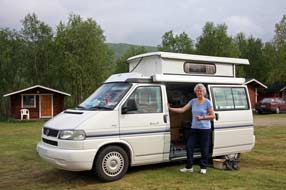|
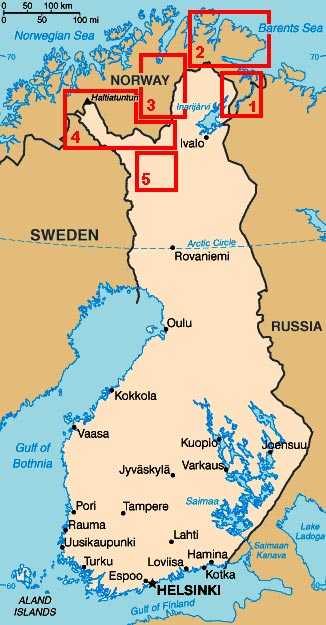 CAMPING
IN NORTHERN NORWAY and FINLAND 2015 - Kirkenes, Øvre
Pasvik Valley, Varanger Fjord and Vestre Jakobselv, Berlevåg, Utsjoki, Karigasniemi, Kautokeino, Karesuando
in Northern Sweden,
Kilpisjärvi and Treriksröset,
Enontekiö, Pyhäjoki, Kittilä: CAMPING
IN NORTHERN NORWAY and FINLAND 2015 - Kirkenes, Øvre
Pasvik Valley, Varanger Fjord and Vestre Jakobselv, Berlevåg, Utsjoki, Karigasniemi, Kautokeino, Karesuando
in Northern Sweden,
Kilpisjärvi and Treriksröset,
Enontekiö, Pyhäjoki, Kittilä:
Into Finnmark (Arctic Norway) at Näätämö
border-crossing: we crossed into Finnmark at the Näätämö
open border-crossing, with the miserably wet weather no better in Norway, and
followed the river down to the Skoltefossen waterfalls at Neiden (click on Map 1
right). Here we turned
east onto the main E6 towards Kirkenes, crossing the headland to drive along the
length of Neidenfjord with the misty rain cloud so low and visibility so poor
that we could make out little detail along the distant coast. The E6 turned
inland over high ground past the military garrison and airfield, dropping down
past Langfjord to Hesseng and on to Kirkenes, Norway's most north-easterly town.
|
Click on 5 highlighted areas of
map for
details of
Arctic Norway and Finland |
 |
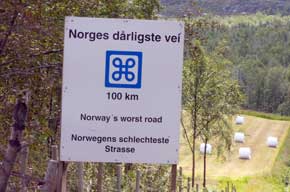 Kirkenes: the rain had eased but the air was still
gloomy, and as we drove into the town, large numbers of parked cars and
closed streets barred our way. We were diverted down to the harbour road where
we managed to find the last of the parking, and walked up into the centre;
streets were filled with stalls and clearly the whole of Kirkenes was en fête
despite the wretched weather; it all seemed totally surrealistic! (see log of our 2014 visit to Kirkenes) Threading our
way through the stalls to the little square with the War Mothers monument, we
found an ATM for Norwegian cash and the Tourist Information Centre (TIC) to
discover what was happening: our arrival had coincided with the 3 day long Kirkenes Summer Festival - some summer! The Library's free wi-fi showed
that this dreary, grey weather was forecast for the next few days. Along the harbour road to Kirkenes' Rema 1000 supermarket,
we stocked with
provisions, and as the pouring rain started again we debated the wisdom of
sticking with our plans to drive 90 kms along the narrow, bumpy road into the Øvre
Pasvik Valley in such fearful weather with little prospect for improvement.
After some consideration, we decided to chance it and extricating ourselves
from the town traffic, we set sat-nav coordinates for Vaggatem and set
off. Kirkenes: the rain had eased but the air was still
gloomy, and as we drove into the town, large numbers of parked cars and
closed streets barred our way. We were diverted down to the harbour road where
we managed to find the last of the parking, and walked up into the centre;
streets were filled with stalls and clearly the whole of Kirkenes was en fête
despite the wretched weather; it all seemed totally surrealistic! (see log of our 2014 visit to Kirkenes) Threading our
way through the stalls to the little square with the War Mothers monument, we
found an ATM for Norwegian cash and the Tourist Information Centre (TIC) to
discover what was happening: our arrival had coincided with the 3 day long Kirkenes Summer Festival - some summer! The Library's free wi-fi showed
that this dreary, grey weather was forecast for the next few days. Along the harbour road to Kirkenes' Rema 1000 supermarket,
we stocked with
provisions, and as the pouring rain started again we debated the wisdom of
sticking with our plans to drive 90 kms along the narrow, bumpy road into the Øvre
Pasvik Valley in such fearful weather with little prospect for improvement.
After some consideration, we decided to chance it and extricating ourselves
from the town traffic, we set sat-nav coordinates for Vaggatem and set
off.
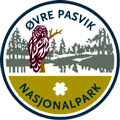 Into
the Øvre
Pasvik Valley: back at Hesseng we turned off onto Route 885, the road which leads down into the Øvre
Pasvik Valley, that remote and curiously anomalous southward projecting salient of Norwegian territory
wedged between the Russian Oblast of Murmansk on the Petsamo peninsula and the remote NE area
of Finland around Lake Inarijärvi (see log of our 2014 visit to the Pasvik Valley).
At least on a Saturday afternoon there were no convoys of trucks from the
re-opened iron mines at Bjørnevatn, and the scoured road had been resurfaced in
the last 12 months. But beyond the turning to the mine spoil heaps, the road surface
was in a dreadful state with entire sections of tarmac totally stripped of
asphalt by constant pounding from mine trucks, and quite justifiably the Norway's worst road sign was still there (see
above left). With the weather gloomily dull, the forests
obscured by pouring misty rain, and the disgraceful road surface to contend
with, it was going to be a wearying 90 km drive into the valley. Into
the Øvre
Pasvik Valley: back at Hesseng we turned off onto Route 885, the road which leads down into the Øvre
Pasvik Valley, that remote and curiously anomalous southward projecting salient of Norwegian territory
wedged between the Russian Oblast of Murmansk on the Petsamo peninsula and the remote NE area
of Finland around Lake Inarijärvi (see log of our 2014 visit to the Pasvik Valley).
At least on a Saturday afternoon there were no convoys of trucks from the
re-opened iron mines at Bjørnevatn, and the scoured road had been resurfaced in
the last 12 months. But beyond the turning to the mine spoil heaps, the road surface
was in a dreadful state with entire sections of tarmac totally stripped of
asphalt by constant pounding from mine trucks, and quite justifiably the Norway's worst road sign was still there (see
above left). With the weather gloomily dull, the forests
obscured by pouring misty rain, and the disgraceful road surface to contend
with, it was going to be a wearying 90 km drive into the valley.
Alongside Langfjord we dropped down around the Bjørnevatn
lakes and the border zone by the Pasvik River. Through the forests, we made slow
progress on the bumpy and poorly maintained road surface, eventually reaching Svanvik. There was little point today
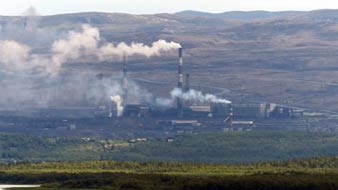 turning off to Høyde 96, the Cold War former military lookout tower; in this poor visibility
the mist would obscure even the river let alone the town of
Nikel which is normally shrouded with smoky emissions from the smelting works
which dominate the town (see left). Today we continued ahead, bumping our way
along the narrow road through endless forest lands passing occasional
farmsteads, sometimes closely alongside the river-border, sometimes further
inland. When we could see the river, the misty Russian territory on the far bank
looked even more gloomily uninviting than ever. On and on the road wound,
shoulder-achingly rutted, with just the occasional local passing car as we
bumped along past the wider water where the Pasvik River swelled out into
Vaggatem Lake. Hay drying racks stretched along the lake shore as we approached
the village of Vaggatem, just a handful of farmsteads, the descendents of the
original settlers sponsored by the Norwegian government to populate this
isolated valley. turning off to Høyde 96, the Cold War former military lookout tower; in this poor visibility
the mist would obscure even the river let alone the town of
Nikel which is normally shrouded with smoky emissions from the smelting works
which dominate the town (see left). Today we continued ahead, bumping our way
along the narrow road through endless forest lands passing occasional
farmsteads, sometimes closely alongside the river-border, sometimes further
inland. When we could see the river, the misty Russian territory on the far bank
looked even more gloomily uninviting than ever. On and on the road wound,
shoulder-achingly rutted, with just the occasional local passing car as we
bumped along past the wider water where the Pasvik River swelled out into
Vaggatem Lake. Hay drying racks stretched along the lake shore as we approached
the village of Vaggatem, just a handful of farmsteads, the descendents of the
original settlers sponsored by the Norwegian government to populate this
isolated valley.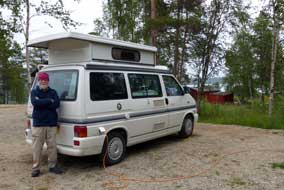
Pasvik Café-Camping: we turned into the driveway of Pasvik
Café-Camping, and settled into a pitch opposite the reception hut, stowing our
food shopping. At least the rain had stopped, but the river-lake was scarcely
visible through the trees in the misty rain-cloud. It had been a long, bumpy and
wearying drive along the valley, but we were here at last at Vaggatem, finally
able to relax with a beer and ease aching shoulders (Photo 1 - Pasvik Café-Camping). The campsite
owner and her family
arrived back from shopping all the way from Kirkenes; the thought of a 3 hour
round trip of almost 200 kms for weekly shopping made the drive to our local
supermarket seem humblingly banal. When they had unloaded their supplies, we
booked in; prices for a stay here at Vaggatem were expensive at 250 NOK/night
plus extra for showers and internet and limited facilities, but even so it was
good to be back at this charactersome and remote spot (see right). Tonight Sevettijärvi
seemed another world away, but the map showed it only a little distance westwards
across the uninhabited Vätsäri wilderness of Northern Finland, and in fact here at Vaggatem we were now well south of last night's stay at Sevettijärvi
(click on Map 1 at top right of page).
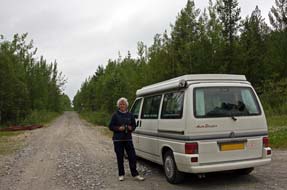 A gloomy day in Øvre
Pasvik Valley:
the following morning the rain had stopped but the sky was still gloomily
overcast; we could even see the river-lake now and greeted the Pasvikelva/Paatsjoki
River which we had last seen a week ago from the Paatsjoki bridge near Nellim as
the river flowed from Lake Inarijärvi. Today after a leisurely morning in camp,
we should drive up to the head of the valley or at least the road's end at Nyrud
border-police post. The campsite owner asked if we were going to venture out to
the Treriksrøysa, the monument at the remote and inaccessible meeting-point of
the borders of Finland, Norway and Russia; the 20kms unsurfaced and bouldery
forestry road had apparently been levelled over the last 12 months. We should
like to reach the monument, but a 40km A gloomy day in Øvre
Pasvik Valley:
the following morning the rain had stopped but the sky was still gloomily
overcast; we could even see the river-lake now and greeted the Pasvikelva/Paatsjoki
River which we had last seen a week ago from the Paatsjoki bridge near Nellim as
the river flowed from Lake Inarijärvi. Today after a leisurely morning in camp,
we should drive up to the head of the valley or at least the road's end at Nyrud
border-police post. The campsite owner asked if we were going to venture out to
the Treriksrøysa, the monument at the remote and inaccessible meeting-point of
the borders of Finland, Norway and Russia; the 20kms unsurfaced and bouldery
forestry road had apparently been levelled over the last 12 months. We should
like to reach the monument, but a 40km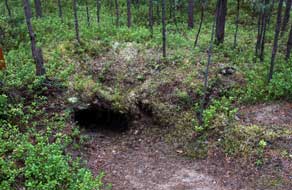 overall drive on rough surface involved
significant risk for the camper's tyres and suspension with still a 10km there
and back trek along the border fence; we should take an investigative look.
Click here for
detailed map of Øvre Pasvik Valley overall drive on rough surface involved
significant risk for the camper's tyres and suspension with still a 10km there
and back trek along the border fence; we should take an investigative look.
Click here for
detailed map of Øvre Pasvik Valley
Beyond Vaggatem village with its 5 farmsteads,
the now even more bumpy lane curved around the enclosed bays of Lake Vaggatem and, along the final section of forested road, reached the now-closed Gløkåsen
police-post and the turning to the Treriksrøysa forest road. We parked here
to investigate the current state of the road (see above left). While the rough
and bouldery surface had been levelled to some extent, this was still not worth
the risk of attempting to force a passage for 20kms along here without a 4WD vehicle, and we continued around the final section of
Route 885 to the Nyrud border-guard station set right on the river border. With
little view through the forest, we returned around to the bird-watching hide (fugelbu
in Norwegian) which overlooks the river-border. An
information
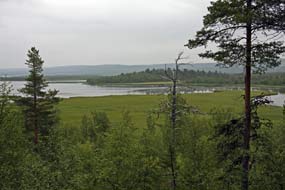 panel detailed a surviving brown bear hibernation den used 2004~06 by a female
bear to give birth to cubs. The bear lacked the natural wariness about human
presence; when this happens, the cubs pick up the trait and have to be culled.
We followed the marked path through the forest and found the long-deserted bear
den dug into the sandy earth (see right). panel detailed a surviving brown bear hibernation den used 2004~06 by a female
bear to give birth to cubs. The bear lacked the natural wariness about human
presence; when this happens, the cubs pick up the trait and have to be culled.
We followed the marked path through the forest and found the long-deserted bear
den dug into the sandy earth (see right).
Back to the parking area and beyond the
reindeer fence, we took the track to the bird-watching hide for some 300m through
the pine and birch forest with its dense ground-cover of Lingonberry;
this year there was no trace of Lingonberry flowers. The hide was set on a
hillock overlooking the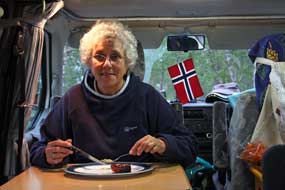 forested river valley; we
opened up the viewing ports but the distant view through the trees was mistily
murky with no sign of any bird-life. In gloomy light we took our photos of the river-border and
distant forests across in Russian territory (see left) (Photo 2 - Russian forests)
and returned to the road. Back along to Vaggatem, we pitched
again at Pasvik Camping; at least this afternoon the overcast conditions had
been a little brighter and there had been no rain. As we sat tonight after
supper (see right), by 10-00pm Norwegian
time there was a visible sense of duskiness; last week around Inarijärvi we had
already noticed the first golden birch leaves of autumn, what the Finns call
Ruska. Tonight, despite it still being only early August, there was a real
feeling of the year moving on towards Arctic autumn; summer simply had not
happened this year, but the mosquitoes were still very much present.
forested river valley; we
opened up the viewing ports but the distant view through the trees was mistily
murky with no sign of any bird-life. In gloomy light we took our photos of the river-border and
distant forests across in Russian territory (see left) (Photo 2 - Russian forests)
and returned to the road. Back along to Vaggatem, we pitched
again at Pasvik Camping; at least this afternoon the overcast conditions had
been a little brighter and there had been no rain. As we sat tonight after
supper (see right), by 10-00pm Norwegian
time there was a visible sense of duskiness; last week around Inarijärvi we had
already noticed the first golden birch leaves of autumn, what the Finns call
Ruska. Tonight, despite it still being only early August, there was a real
feeling of the year moving on towards Arctic autumn; summer simply had not
happened this year, but the mosquitoes were still very much present.
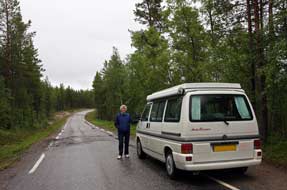 Return
along the bumpy Pasvik Valley road: the following morning
was still as gloomy as ever, now with drizzly rain. Before leaving we talked more
with the campsite owner about life in the valley: winters were bitterly cold
with typical temperatures of -40°C, but less snow than might be expected. She
offered to transport us out to the Treriksrøysa in her vehicle, for the princely
sum of 2,000 NOK (around £200!); the Three Countries Monument will have to remain one of those ever
inaccessible aspirations! We said our farewells to Pasvik Camping, and before leaving Vaggatem, paused for photos in the Øvre
Pasvik forests (see left)
(Photo 3 - Pasvik Valley forests on a wet morning).
After a brief and again disappointingly gloomy stay in the valley, we finally
began the return along Route 885; it was going to be another long and bumpy
drive 90 kms from our start point almost at the head of the Pasvik Valley. There
was more traffic about this morning as locals from along the valley passed to
and fro. With gloomy rain cloud and drizzle continuing, it took a wearying hour
to reach Svanvik where we paused at the Co-op mini-market for a few items of
provisions. Beyond the final Pasvik lakes, we said our farewells to the river
which continued its wider course to flow into the Barents Sea east of Kirkenes
at Jakobsnes where in early 20th century, sawmills had cut up timber floated
downriver from around Inarijärvi. Route 885 rose over higher ground forming
the watershed which divides the Pasvik from waters which drain into Langfjord to flow into
Varanger Fjord west of Kirkenes. Return
along the bumpy Pasvik Valley road: the following morning
was still as gloomy as ever, now with drizzly rain. Before leaving we talked more
with the campsite owner about life in the valley: winters were bitterly cold
with typical temperatures of -40°C, but less snow than might be expected. She
offered to transport us out to the Treriksrøysa in her vehicle, for the princely
sum of 2,000 NOK (around £200!); the Three Countries Monument will have to remain one of those ever
inaccessible aspirations! We said our farewells to Pasvik Camping, and before leaving Vaggatem, paused for photos in the Øvre
Pasvik forests (see left)
(Photo 3 - Pasvik Valley forests on a wet morning).
After a brief and again disappointingly gloomy stay in the valley, we finally
began the return along Route 885; it was going to be another long and bumpy
drive 90 kms from our start point almost at the head of the Pasvik Valley. There
was more traffic about this morning as locals from along the valley passed to
and fro. With gloomy rain cloud and drizzle continuing, it took a wearying hour
to reach Svanvik where we paused at the Co-op mini-market for a few items of
provisions. Beyond the final Pasvik lakes, we said our farewells to the river
which continued its wider course to flow into the Barents Sea east of Kirkenes
at Jakobsnes where in early 20th century, sawmills had cut up timber floated
downriver from around Inarijärvi. Route 885 rose over higher ground forming
the watershed which divides the Pasvik from waters which drain into Langfjord to flow into
Varanger Fjord west of Kirkenes.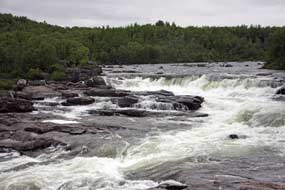 The road passed high above Langfjord, finally
reaching the ugly scar of the Bjørnevatn iron mines spoil heaps where a mine
truck was poised on the sky line to tip yet more waste rock, adding to this area
of dereliction. We bumped along the scarred road relieved finally to reach the junction
with E6's smoother tarmac at Hesseng, almost 2 hours after leaving the bottom
end of the Øvre
Pasvik Valley. The road passed high above Langfjord, finally
reaching the ugly scar of the Bjørnevatn iron mines spoil heaps where a mine
truck was poised on the sky line to tip yet more waste rock, adding to this area
of dereliction. We bumped along the scarred road relieved finally to reach the junction
with E6's smoother tarmac at Hesseng, almost 2 hours after leaving the bottom
end of the Øvre
Pasvik Valley.
Around Varanger Fjord to Vestre Jakobselv:
setting the satnav for Vestre Jakobselv, we turned westwards on E6 (click on Map
2 at top right of page). The rain of earlier had eased and the sky a little
brighter although still heavily overcast. Over the high
ground past the airfield, the road descended to Neidenfjord and we kept up a
steady pace around its shoreline to the Neiden river crossing at the E6/Route
893 junction. Here we paused for passing photos of the Skoltefossen waterfalls
which looked totally monochrome in today's grey light
(Photo 4 - Skoltefossen waterfalls) (see right).
Traffic on E6 was surprisingly light as we continued westwards across the high
fell-scape with its open vistas of distant higher fells across wilderness
terrain. The E6
passed
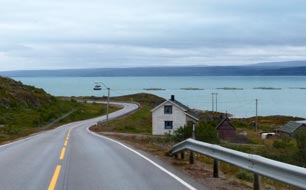 over areas of craggy hills enclosing elongated lakes, the birch trees
here showing extensive blackening damage from defoliation by the destructive
Autumnal Moth caterpillars. over areas of craggy hills enclosing elongated lakes, the birch trees
here showing extensive blackening damage from defoliation by the destructive
Autumnal Moth caterpillars.
The road descended to the southern shore of
Varanger Fjord which from a distance, despite the grey gloomy sky, glowed a
curious turquoise colour, as we had seen last year in Norway on lakes and
fjords fed by waters rich in glacially-scoured sediment (see left). Along the
shore-line of Varanger Fjord, passing through the occasional settlement, the
road finally swung northwards around the head of the fjord to reach the road
junction a Varangerbotn. Here we turned eastwards on E75 along the northern
shore, the sky leaden-grey with heavy rain-cloud covering the southern
shore-line, and the fjord's waters still glowing the opalescent
turquoise colour, never before noticed here before. We passed through Nessby with
its distant landmark church down by the fjord, and over higher ground by the
Mortensnes nature reserve,
finally reaching the scattered settlement of Vestre Jakobselv with its
fish-drying racks and little harbour, around the mouth of the Jakobselva river.
We turned up to Vestre Jakobselv Camping,
now the only remaining campsite on the entire northern
shore of Varanger Fjord, part of a Youth Mission Centre. As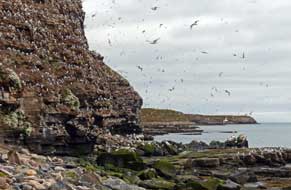 always we received a
warm welcome and our details were still on their computer from our several past
stays at what is without doubt one of Norway's most hospitable campsites; its
good value price includes showers, wi-fi and use of the washing/drying machines. always we received a
warm welcome and our details were still on their computer from our several past
stays at what is without doubt one of Norway's most hospitable campsites; its
good value price includes showers, wi-fi and use of the washing/drying machines.
Ekkerøy kittiwake nesting cliffs:
we reserved our pitch close to the facilities hut, and drove on the 15 kms to
Vadsø, the main town and service centre along the Varanger Fjord northern shore.
Reaching the little town, the number of dark-skinned immigrants, Somali or
Ethiopian, was immediately apparent;
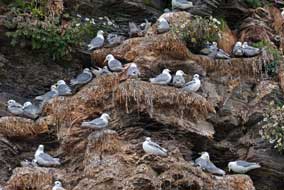 from the heat of the Horn of Africa to the
Arctic chill of Vadsø, they looked not a happy bunch. We continued ahead past
the airfield up on the hill-top plateau and passed through the small
fishing-farming villages with grazing sheep lining the road and dual
warning-signs for sheep and reindeer. Some 12 kms further around the coast, we
turned off onto the small peninsula of Ekkerøy with its fishing hamlet curving
around the bay. As the ending -øy suggests, this was once a tiny off-shore
island, now connected to the mainland by a sandy isthmus. The former fish and
shrimp packing factory now houses a small museum devoted to the fishing industry
which grew up in Eastern Finnmark and 19th century Finnish/Kven colonisation of
the Kola/Petsamo Peninsula; this admirable little museum at Ekkerøy, welcoming
and free-entry, gives an insightful history of this obscure and little known
region of Petsamo and is well worth a visit. But the reason for our return today was to
visit Ekkerøy's Nature Reserve on the cliffs which face south towards Varanger
Fjord; during the March~August breeding season, colonies of some 30,000 pairs of
Kittiwakes nest on the cliff ledges. Following the turf track around from the
village, as we approached the line of cliffs, the sound of Kittiwake calls
became louder, with snowy squalls of from the heat of the Horn of Africa to the
Arctic chill of Vadsø, they looked not a happy bunch. We continued ahead past
the airfield up on the hill-top plateau and passed through the small
fishing-farming villages with grazing sheep lining the road and dual
warning-signs for sheep and reindeer. Some 12 kms further around the coast, we
turned off onto the small peninsula of Ekkerøy with its fishing hamlet curving
around the bay. As the ending -øy suggests, this was once a tiny off-shore
island, now connected to the mainland by a sandy isthmus. The former fish and
shrimp packing factory now houses a small museum devoted to the fishing industry
which grew up in Eastern Finnmark and 19th century Finnish/Kven colonisation of
the Kola/Petsamo Peninsula; this admirable little museum at Ekkerøy, welcoming
and free-entry, gives an insightful history of this obscure and little known
region of Petsamo and is well worth a visit. But the reason for our return today was to
visit Ekkerøy's Nature Reserve on the cliffs which face south towards Varanger
Fjord; during the March~August breeding season, colonies of some 30,000 pairs of
Kittiwakes nest on the cliff ledges. Following the turf track around from the
village, as we approached the line of cliffs, the sound of Kittiwake calls
became louder, with snowy squalls of
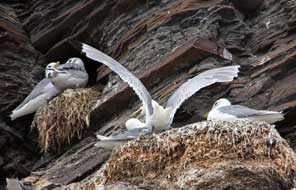 the flocking birds swirling around.
Reaching the rocky beach, the entire cliff-face was covered with nesting birds
(see above right),
this year's young now grown to juvenile size still standing by the
remains of filthy nests
(see above left) (Photo 5 - Kittiwake colonies on Ekkerøy cliffs).
Adult birds swooped in bringing back fish to feed the greedy youngsters
(see right) (Photo
6 - Adult Kittiwakes returning with food). Kittiwakes spend the winter months out on
the open sea, only returning in March to nest on the cliffs of Ekkerøy and rear
their young, leaving again in August when the young are grown. We were just
in time this year to see them on the cliffs; another week or so and they would
have returned to sea for winter feeding. The air was filled with the shrieking
Kittiwake cries, as adult birds swooped and dived to the nests and out
again. Almost mesmerised, we stood photographing this thronging, shrieking mass
of birds as
they fed their young
(Photo
7 - Juvenile Kittiwakes). the flocking birds swirling around.
Reaching the rocky beach, the entire cliff-face was covered with nesting birds
(see above right),
this year's young now grown to juvenile size still standing by the
remains of filthy nests
(see above left) (Photo 5 - Kittiwake colonies on Ekkerøy cliffs).
Adult birds swooped in bringing back fish to feed the greedy youngsters
(see right) (Photo
6 - Adult Kittiwakes returning with food). Kittiwakes spend the winter months out on
the open sea, only returning in March to nest on the cliffs of Ekkerøy and rear
their young, leaving again in August when the young are grown. We were just
in time this year to see them on the cliffs; another week or so and they would
have returned to sea for winter feeding. The air was filled with the shrieking
Kittiwake cries, as adult birds swooped and dived to the nests and out
again. Almost mesmerised, we stood photographing this thronging, shrieking mass
of birds as
they fed their young
(Photo
7 - Juvenile Kittiwakes).
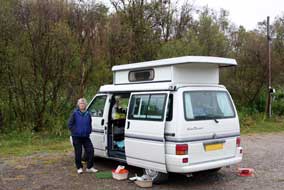 Back along to Vadsø we re-stocked with provisions at the Rema 1000 supermarket
and returned to Vestre Jakobselv Camping (see left) where Sheila put on our next
load of laundry in the campsite washing machine. It had been a satisfying
wearying day with a long drive from what now seemed far-away Pasvik Valley, and
with the still heavily overcast sky, the late evening was again dusky. Back along to Vadsø we re-stocked with provisions at the Rema 1000 supermarket
and returned to Vestre Jakobselv Camping (see left) where Sheila put on our next
load of laundry in the campsite washing machine. It had been a satisfying
wearying day with a long drive from what now seemed far-away Pasvik Valley, and
with the still heavily overcast sky, the late evening was again dusky.
North to Berlevåg in wretched weather and poor visibility:
it seems repetitious to say it rained heavily during the night, but such was the
frustratingly poor summer of 2015 that this morning George was sat in a 2 inch
mini-lake of rainwater, and the sky as heavily overcast as ever. Vestre
Jakobselv's showers had been upgraded since our last visit and on a chill
morning the heating was most welcome. With murkily low rain-cloud shrouding the
distant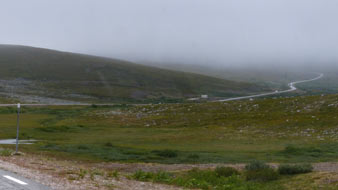 fells and soaking drizzle filling the air, we returned along the fjord-side E75 to
Varangerbotn on a thoroughly miserable morning. In poor visibility we set off
over the fells towards Skiippagurra. The birches along this stretch were
totally devastated by Autumnal Moth caterpillar defoliation; all the dead and
blackened trees presented a sorry sight. Dropping down to the road junction by
the dreary-looking campsite at Skiippagurra, we turned north and pulled into the
picnic area opposite the Tana Bru suspension bridge for our sandwich lunch;
this lovely spot was a dreary, sodden place on such a wet and cheerless
day. Beyond the bridge we continued north on Route 890, running alongside the
wide, sandy estuary of the Tana River (click on Map 2 at top right of page),
passing the farms along this lower stretch. The high fells on the far side of
the river
were almost totally hidden in rain cloud, and the high, craggy cliffs rising above
this side of the river seemed even more menacing than ever in the dark, misty
conditions. Beyond the turning to Høyholmen, the road rounded towards the
fells and soaking drizzle filling the air, we returned along the fjord-side E75 to
Varangerbotn on a thoroughly miserable morning. In poor visibility we set off
over the fells towards Skiippagurra. The birches along this stretch were
totally devastated by Autumnal Moth caterpillar defoliation; all the dead and
blackened trees presented a sorry sight. Dropping down to the road junction by
the dreary-looking campsite at Skiippagurra, we turned north and pulled into the
picnic area opposite the Tana Bru suspension bridge for our sandwich lunch;
this lovely spot was a dreary, sodden place on such a wet and cheerless
day. Beyond the bridge we continued north on Route 890, running alongside the
wide, sandy estuary of the Tana River (click on Map 2 at top right of page),
passing the farms along this lower stretch. The high fells on the far side of
the river
were almost totally hidden in rain cloud, and the high, craggy cliffs rising above
this side of the river seemed even more menacing than ever in the dark, misty
conditions. Beyond the turning to Høyholmen, the road rounded towards the
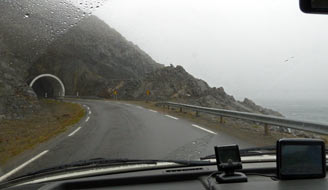 village of Leirpollen, with low cloud covering the featuresome cliffs on the
northern side of the fjord. village of Leirpollen, with low cloud covering the featuresome cliffs on the
northern side of the fjord.
Beyond the Leirpollen farms, we passed the
vegbom and began the long climb into the Kongsfjord fells, the weather now
even gloomier with the rain-cloud almost down to road level.
George tackled the steadily rising gradient resolutely as we gained height in
the ever increasing misty conditions across the broad, treeless stony fells,
empty of any sign of life and menacingly gloomy in the poor visibility. It seemed
further than ever across the fell top plateau (see
above right) before we finally
reached the road junction at Gednje and turned westwards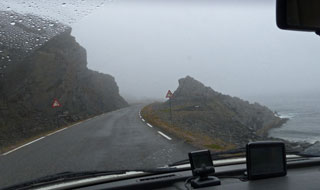 towards Berlevåg with
50 kms still to drive around the northern coast. As the road began the long
descent into the rocky defile of Kongsfjorddalen, the all-enveloping mist became
even denser, obscuring the mountainous surroundings. Dropping down towards the
coast at Vesterbotn, visibility was even further reduced so that the houses of
Kongsfjord were lost in the mist as we passed through. Never before had we
driven around this magnificent coastline in such horrendous conditions. Along
the far side of Risfjord, we rounded the point and cautiously edged through the
tunnel (see above left), the road ahead totally obscured in the mist. Around Sandfjord bay and
under the landward cliffs on the far side, we moved slowly along the Barents Sea
northern coast (see right), fearful about the fragments of sea-urchin shells cracked by
gulls for the soft flesh and now littering the road, each one a potential
puncture trap. In such poor visibility (see left), it was impossible to see the lighthouse
as we drove slowly towards Berlevåg passing a few towards Berlevåg with
50 kms still to drive around the northern coast. As the road began the long
descent into the rocky defile of Kongsfjorddalen, the all-enveloping mist became
even denser, obscuring the mountainous surroundings. Dropping down towards the
coast at Vesterbotn, visibility was even further reduced so that the houses of
Kongsfjord were lost in the mist as we passed through. Never before had we
driven around this magnificent coastline in such horrendous conditions. Along
the far side of Risfjord, we rounded the point and cautiously edged through the
tunnel (see above left), the road ahead totally obscured in the mist. Around Sandfjord bay and
under the landward cliffs on the far side, we moved slowly along the Barents Sea
northern coast (see right), fearful about the fragments of sea-urchin shells cracked by
gulls for the soft flesh and now littering the road, each one a potential
puncture trap. In such poor visibility (see left), it was impossible to see the lighthouse
as we drove slowly towards Berlevåg passing a few
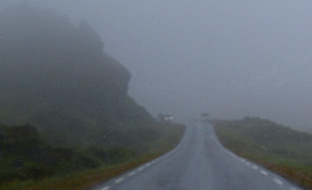 bedraggled
reindeer in the mist (Photo
8 - Bedraggled reindeer). We were relieved when at last we passed the far vegbom and the side-lane to the Hurtigrute
quay; ahead the tetrapod memorial
loomed out of the mist and we turned along to the familiar blue and white
painted wooden building of Berlevåg Pensjonat og Camping. bedraggled
reindeer in the mist (Photo
8 - Bedraggled reindeer). We were relieved when at last we passed the far vegbom and the side-lane to the Hurtigrute
quay; ahead the tetrapod memorial
loomed out of the mist and we turned along to the familiar blue and white
painted wooden building of Berlevåg Pensjonat og Camping.
Berlevåg Pension and Camping: the
rain of the last 48 hours had caused water-logging in the already limited
camping area; the grass is inevitably always a little careworn, but this far
north with snow
covering the ground from November to May and Polar darkness for 2 months, it is
a wonder the campsite has any turf at all. Weary after a long drive in such
appalling conditions, we went inside the familiar pension, to be greeted hospitably and like
old friends by the owner Dieter Salathe, of Swiss origin and quietly reserved
but ever helpful and warmly welcoming.
He brought us up to date with events of the last 12 months since we were last
here in Berlevåg: the inner harbour was being extended for the still prospering
fishing fleet, and new breakwaters were under construction. We again discussed the
vagaries of the Hurtigrute's calling at the port and the financial impact on the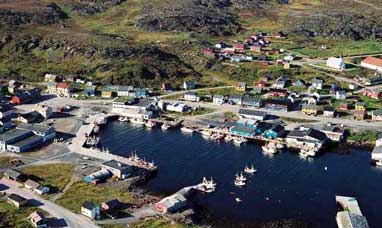 commune of loss of harbour dues if the coastal steamer failed to call. With
his customary hospitality, Dieter helped us to pitch, suggesting a flat and
dryish spot by
the pension building and organising a power connection, and we quickly settled
to get out of the chill and soaking sea mist. We had never been at Berlevåg in what seemed to us such inclement weather, but compared with the
conditions here of Arctic winter, in which men still went to sea for the
fishing, a bit of sea mist really was nothing to complain about. That is one
of Berlevåg's most endearing and humbling features: the conditions of living and working here
on this barren and isolated Barents Sea coast 100 kms from the nearest inland
settlement make Berlevåg an admirably self-sufficient and tight-knit community.
With the sea still providing Berlevåg's major source of livelihood, fishing and
fishing-support industries are the economic
mainstay and major employers in this remote community. The little town with its
boat repair yards and fish-processing factories is clustered around its inner
harbour, a reinforced natural inlet of the Barents Sea, where the fishing
fleets is moored. The outer harbour is enclosed and protected from savage
Barents Sea storms by the 2 long arms of the harbour mole. From where we were
camped, we could just about make out in the mist the distant gap in the outer
harbour mole and the tetrapods from which the mole wall was constructed. Berlevåg's church stands up on the hill overlooking the town and harbour, with
houses spread up the hill-side from the water-front. See right for an aerial
view of Berlevåg fishing harbour, and click here for
detailed map of Berlevåg.
commune of loss of harbour dues if the coastal steamer failed to call. With
his customary hospitality, Dieter helped us to pitch, suggesting a flat and
dryish spot by
the pension building and organising a power connection, and we quickly settled
to get out of the chill and soaking sea mist. We had never been at Berlevåg in what seemed to us such inclement weather, but compared with the
conditions here of Arctic winter, in which men still went to sea for the
fishing, a bit of sea mist really was nothing to complain about. That is one
of Berlevåg's most endearing and humbling features: the conditions of living and working here
on this barren and isolated Barents Sea coast 100 kms from the nearest inland
settlement make Berlevåg an admirably self-sufficient and tight-knit community.
With the sea still providing Berlevåg's major source of livelihood, fishing and
fishing-support industries are the economic
mainstay and major employers in this remote community. The little town with its
boat repair yards and fish-processing factories is clustered around its inner
harbour, a reinforced natural inlet of the Barents Sea, where the fishing
fleets is moored. The outer harbour is enclosed and protected from savage
Barents Sea storms by the 2 long arms of the harbour mole. From where we were
camped, we could just about make out in the mist the distant gap in the outer
harbour mole and the tetrapods from which the mole wall was constructed. Berlevåg's church stands up on the hill overlooking the town and harbour, with
houses spread up the hill-side from the water-front. See right for an aerial
view of Berlevåg fishing harbour, and click here for
detailed map of Berlevåg.
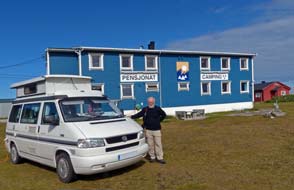 The campsite's
strong wi-fi signal covered
the whole camping area, and after a fortnight of being without internet access,
there was much to catch up with. Occasionally we peered out into the obscure
misty surroundings from the snug warmth and comfort of the camper. That evening
after supper, we sat listening to the wonderfully nostalgic music of the Berlevåg Men's Choir (Berlevåg Mannsangforening) singing their familiar songs
from Knut Erik Jensen's 2001 film Heftig og Begeistret (Cool and Crazy),
as the misty evening grew gloomily dusky. At 10-15pm we watched out for the
arrival of the north-bound
Hurtigrute coastal steamer which suddenly loomed out of the mist at the gap in
the outer harbour mole like some mysterious
sea
creature, its lights twinkling
in the gloom. We could not distinguish the ship's name but the 2 words suggested
it was M/S Richard With, named after the originating founder of
the Hurtigrute Line. The coastal steamer swung around in the outer harbour to dock
at the The campsite's
strong wi-fi signal covered
the whole camping area, and after a fortnight of being without internet access,
there was much to catch up with. Occasionally we peered out into the obscure
misty surroundings from the snug warmth and comfort of the camper. That evening
after supper, we sat listening to the wonderfully nostalgic music of the Berlevåg Men's Choir (Berlevåg Mannsangforening) singing their familiar songs
from Knut Erik Jensen's 2001 film Heftig og Begeistret (Cool and Crazy),
as the misty evening grew gloomily dusky. At 10-15pm we watched out for the
arrival of the north-bound
Hurtigrute coastal steamer which suddenly loomed out of the mist at the gap in
the outer harbour mole like some mysterious
sea
creature, its lights twinkling
in the gloom. We could not distinguish the ship's name but the 2 words suggested
it was M/S Richard With, named after the originating founder of
the Hurtigrute Line. The coastal steamer swung around in the outer harbour to dock
at the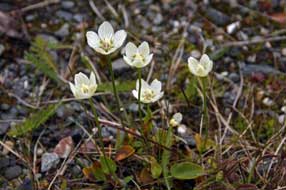 Hurtigrute quay. Half hour later the south-bound boat appeared out
of the
mist as its north-bound
sister departed, the 2 ships passing at the mole gap with the usual reciprocal
fanfare of horns. Tonight in the chill, misty gloom, we watched this nightly
passing of the north- and south-bound Hurtigrute from the snug comfort of the
camper. Hurtigrute quay. Half hour later the south-bound boat appeared out
of the
mist as its north-bound
sister departed, the 2 ships passing at the mole gap with the usual reciprocal
fanfare of horns. Tonight in the chill, misty gloom, we watched this nightly
passing of the north- and south-bound Hurtigrute from the snug comfort of the
camper.
A sunny day (at last) around Berlevåg: the following morning the
cloudy sky was just breaking and the forecast warming, welcome sun beginning to
shine through, the first time seemingly in weeks! Facilities at Berlevåg
Pension-Camping were first class and the homely showers so welcome after so many
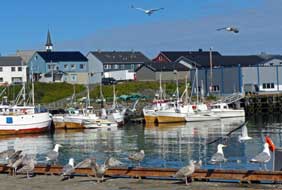 primitive campsite showers recently. The fully equipped kitchen must be one of
best campsite kitchens in the whole of Scandinavia. Although expensive at 260 NOK, Berlevåg Pension-Camping is certainly
a well-run, hospitable and good value campsite, one of the best in Norway (Photo
9 - Berlevåg Pension-Camping) (see above left). primitive campsite showers recently. The fully equipped kitchen must be one of
best campsite kitchens in the whole of Scandinavia. Although expensive at 260 NOK, Berlevåg Pension-Camping is certainly
a well-run, hospitable and good value campsite, one of the best in Norway (Photo
9 - Berlevåg Pension-Camping) (see above left).
In remarkably warm sunshine we set off for our
day around Berlevåg, firstly walking over to the headland both to see for
ourselves what was happening with the harbour extension and to photograph the
Arctic Poppies and Grass of Parnassus wild flora growing among the slatey rocks
(see above right). The harbour-side workshops area was a mess with diggers loading heaps of excavated rubble lining the waterside into lorries. From a rig-like
assembly out in the centre of the inner harbour, another digger was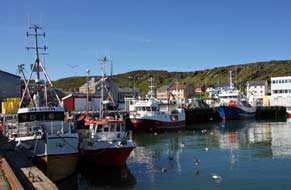 scooping rubble from the sea bed, presumably to deepen and widen the inner harbour and
extend the moles to allow larger fishing vessels to dock here, hopefully good
news for Berlevåg's fishing fleet and the town's economy
(Photo
10 - Harbour excavations). In the bright
sunshine, we took our photos looking across the fishing boats moored around the
inner harbour set against the backdrop of Berlevåg's white-painted church up on
the far hill-side (Photo
11 - Berlevåg inner harbour) (see left). We walked around past the fish-processing factories to Storgata on the far side of the harbour; the work of unloading, sorting and
packing today's catch was completed, scooping rubble from the sea bed, presumably to deepen and widen the inner harbour and
extend the moles to allow larger fishing vessels to dock here, hopefully good
news for Berlevåg's fishing fleet and the town's economy
(Photo
10 - Harbour excavations). In the bright
sunshine, we took our photos looking across the fishing boats moored around the
inner harbour set against the backdrop of Berlevåg's white-painted church up on
the far hill-side (Photo
11 - Berlevåg inner harbour) (see left). We walked around past the fish-processing factories to Storgata on the far side of the harbour; the work of unloading, sorting and
packing today's catch was completed,
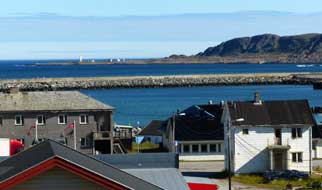 refrigerated trucks were moving off, and
the empty boats stood moored at the harbour-side (Photo
12 - Berlevåg's fishing fleet) (see right). As
we stood looking down over the harbour extensions excavations, the alert sounded
for imminent blasting; the earth literally moved and the bang sent a flurry of
gulls into the air in panic. We tried again to get haircuts at Berlevåg's
frisørbua (hairdressers) but this year they were closed for holidays. Instead we went
next door to sit in sunshine on the terrace of the Neptun pub to eat our
lunch sandwiches with glasses of Macks beer, glancing at the elderly locals on the next
table to see if any looked like stars from Heftig og Begeistret. refrigerated trucks were moving off, and
the empty boats stood moored at the harbour-side (Photo
12 - Berlevåg's fishing fleet) (see right). As
we stood looking down over the harbour extensions excavations, the alert sounded
for imminent blasting; the earth literally moved and the bang sent a flurry of
gulls into the air in panic. We tried again to get haircuts at Berlevåg's
frisørbua (hairdressers) but this year they were closed for holidays. Instead we went
next door to sit in sunshine on the terrace of the Neptun pub to eat our
lunch sandwiches with glasses of Macks beer, glancing at the elderly locals on the next
table to see if any looked like stars from Heftig og Begeistret.
Up on the hill we stood at the church's front terrace looking down over the town's wooden houses towards the harbour mole
and distant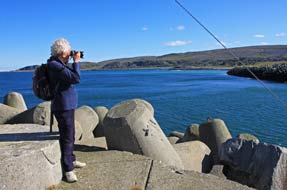 lighthouse,
and the Barents Sea beyond, unusually a still calm in today's sunshine (see left) (Photo
13 - View over town and harbour mole). Back
down into the town, we paid our respects at the memorial to men from Berlevåg who
had died at German hands in the Kirkenes slave-labour camp during the WW2 occupation. Past
the Sangernes Hus,
headquarters of the Berlevåg Men's Choir, we cut through towards the harbour and
the trackway leading around to the northern mole (see right). Out along to the end of the
mole, built of the interlocking tetrapods, we could look out over the outer
harbour as a tug towed a barge full of excavated debris from the harbour
extension works to dump out at sea (Photo
14 - Berlevåg harbour mole). Back around lighthouse,
and the Barents Sea beyond, unusually a still calm in today's sunshine (see left) (Photo
13 - View over town and harbour mole). Back
down into the town, we paid our respects at the memorial to men from Berlevåg who
had died at German hands in the Kirkenes slave-labour camp during the WW2 occupation. Past
the Sangernes Hus,
headquarters of the Berlevåg Men's Choir, we cut through towards the harbour and
the trackway leading around to the northern mole (see right). Out along to the end of the
mole, built of the interlocking tetrapods, we could look out over the outer
harbour as a tug towed a barge full of excavated debris from the harbour
extension works to dump out at sea (Photo
14 - Berlevåg harbour mole). Back around
 Sjøgata (Sea Street) into the
town, we shopped for provisions at the Spa mini-market and returned to camp
around the inner harbour
(Photo
15 - Berlevåg fishing harbour). With the sun still warm, we were able quite
unprecedentedly this year to sit outside with mugs of tea, before cooking an
exotic supper of whale meat stroganoff in the campsite kitchen. Sjøgata (Sea Street) into the
town, we shopped for provisions at the Spa mini-market and returned to camp
around the inner harbour
(Photo
15 - Berlevåg fishing harbour). With the sun still warm, we were able quite
unprecedentedly this year to sit outside with mugs of tea, before cooking an
exotic supper of whale meat stroganoff in the campsite kitchen.
Hurtigrute coastal steamers passing at Berlevåg: later in the evening,
the throb of a ship's diesel engines could be heard. It was only 10-00pm but we
walked over, surprised to discover that tonight's north-bound Hurtigrute had
already slipped into the outer harbour without our realising it and was
already docked at the quay; it was early and there would be no passing of ships
tonight at the harbour entrance. The sun had declined at a shallow angle and was
now setting above the silhouetted outline of houses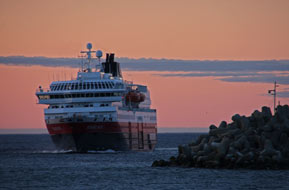 along the Berlevåg sky-line
(see left) (Photo
16 - Setting sun over Berlevåg sky-line).
As the north-bound M/S Nord Norge swung around from the quay and turned
onto its departing course through the mole gap, we managed to get photos of the
setting sun's golden light reflected along the coastal steamer's side, and
of her heading away to sea en route to Båtsfjord (Photo
17 - Hurtigrute leaving Berlevåg ). In the distance, the
misty shape of the approaching south-bound Hurtigrute could just be made out, as
the 2 ships passed way out at sea tonight. M/S Richard With returning
south from Kirkenes and seen last night on its north-bound passage, appeared at the
far side of the mole gap to enter the outer harbour (see right), swinging around to its
quay-side mooring and briefly caching the sun's now after-setting along the Berlevåg sky-line
(see left) (Photo
16 - Setting sun over Berlevåg sky-line).
As the north-bound M/S Nord Norge swung around from the quay and turned
onto its departing course through the mole gap, we managed to get photos of the
setting sun's golden light reflected along the coastal steamer's side, and
of her heading away to sea en route to Båtsfjord (Photo
17 - Hurtigrute leaving Berlevåg ). In the distance, the
misty shape of the approaching south-bound Hurtigrute could just be made out, as
the 2 ships passed way out at sea tonight. M/S Richard With returning
south from Kirkenes and seen last night on its north-bound passage, appeared at the
far side of the mole gap to enter the outer harbour (see right), swinging around to its
quay-side mooring and briefly caching the sun's now after-setting
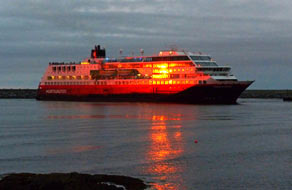 golden glow
along its side. Both ships were early tonight. The liner backed from the quay
and turned onto her departing course through the mole gap, to pick up speed away southwards, with the sun now fully set and the sky dusky dark. golden glow
along its side. Both ships were early tonight. The liner backed from the quay
and turned onto her departing course through the mole gap, to pick up speed away southwards, with the sun now fully set and the sky dusky dark.
The following morning was overcast but bright
for our day in camp, to the constant background noise of harbour excavations.
After supper we hurried over to the headland just in time as the north-bound
M/S Trollfjord approached the mole gap to pass into the harbour with the
setting sun's glow catching her side as she swung round to the Hurtigrute quay (Photo
18 - M/S Trollfjord catching glow of setting sun) (see left).
10 minutes later as she backed from her mooring, the south-bound M/S
Nord Norge appeared in the distance well out to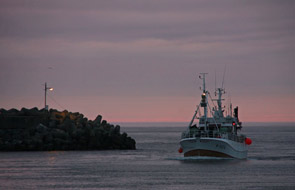 sea; again there would be no
passing of ships at the mole gap tonight. Trollfjord swung around and
Nord Norge made good progress, so that the 2 ships crossed just outside the
harbour with the usual fanfare of horns. As Nord Norge prepared to
depart, 2 of Berlevåg's larger fishing boats were approaching the mole gap. One
just got through as the south-bound Hurtigrute swung around through the harbour
entrance; the
other paused to allow the coastal steamer through before entering the outer
harbour, to form our final photographic shot in the gathering dusk tonight (Photo
19 - Hurtigrute and fishing boat passing at harbour entrance) (see
right). We returned to the
campsite in the dusky gloom of late evening, after our 3 day refreshing stay
here at Berlevåg; tomorrow we should return south crossing back into Northern Finland
at Nuorgam to camp at Utsjoki (click on Map 2 at top right of page). sea; again there would be no
passing of ships at the mole gap tonight. Trollfjord swung around and
Nord Norge made good progress, so that the 2 ships crossed just outside the
harbour with the usual fanfare of horns. As Nord Norge prepared to
depart, 2 of Berlevåg's larger fishing boats were approaching the mole gap. One
just got through as the south-bound Hurtigrute swung around through the harbour
entrance; the
other paused to allow the coastal steamer through before entering the outer
harbour, to form our final photographic shot in the gathering dusk tonight (Photo
19 - Hurtigrute and fishing boat passing at harbour entrance) (see
right). We returned to the
campsite in the dusky gloom of late evening, after our 3 day refreshing stay
here at Berlevåg; tomorrow we should return south crossing back into Northern Finland
at Nuorgam to camp at Utsjoki (click on Map 2 at top right of page).
Another gift of cod from Berlevåg:
after rain during the night, we awoke to a dull, grey morning again for our
drive south. When we went into the pension to settle up our 3 days' rent,
Dieter's wife Daniela gave us a copy of the Berlevåg community magazine with all
its local news and announcements, and an aerial photo of the harbour showing
details of the enlargement works: the harbour was being deepened to 7m with
additional mooring to accommodate Berlevåg's increasing number of larger fishing
vessels, and a 5m deep anchorage created for smaller boats. The inner moles were
being strengthened and extended for extra
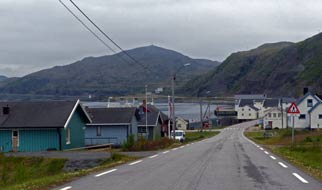 protection against winter storms. The
work had received government financial support and would bring much needed help
to the community. Before leaving the town, we returned to the harbour to say
hello to the Breton owner of Berle Fisk, the fish packing
warehouse down at the harbour side, whom we
had met on our last visit. He was not there today, but his staff promised to
pass on our good wishes; they also presented us with a huge cod from last
night's catch, for our supper tonight they said, refusing to take any payment.
We finally - and sadly - departed protection against winter storms. The
work had received government financial support and would bring much needed help
to the community. Before leaving the town, we returned to the harbour to say
hello to the Breton owner of Berle Fisk, the fish packing
warehouse down at the harbour side, whom we
had met on our last visit. He was not there today, but his staff promised to
pass on our good wishes; they also presented us with a huge cod from last
night's catch, for our supper tonight they said, refusing to take any payment.
We finally - and sadly - departed Berlevåg or this year, having felt so very
much at home in this hard-working community; when should we return? Berlevåg or this year, having felt so very
much at home in this hard-working community; when should we return?
Return drive to Tana Bru:
although overcast this morning, at least visibility was better for our return
drive; we could actually see around the coast to the lighthouse. We wound our
way around the sweeping bays among the jagged slatey rocks and over-towering
cliffs, through the tunnel cut through the headland, and around the coast to
Kongsfjord (see above left), to begin the long haul up onto Kongsfjordfjell. As
we passed Vesterbotn to begin the climb of Kongsfjorddalen, a sea eagle soared
overhead, its white tail clearly visible. A parked snow-mobile at the fell-top
Sámi settlement served as a reminder of winter conditions up here (see right).
We continued across the broad plateau to the road junction at Gednje and turned
south, the narrow road stretching endlessly across the open fell-scape into the
distance and loosing height
gradually down to reach the first birches of the tree-line and the farms of the
lower valley. The road passed around the Tana estuary finally
coming within sight of Tana Bru.
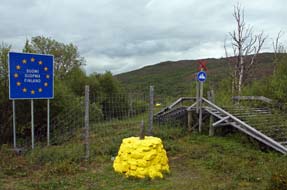 Across the Finnish border at Nuorgam and
along the Tana/Teno River to Utsjoki:
at Skiippagurra, we turned off onto Route 895 around to the national border just
beyond Polmak, still following the River Tana (Norwegian)/Teno (Finnish) which
forms the border between the 2 countries. On a minor road such as this, it felt
as if we were slipping back into Finland by the back door! Just across the
border at Nuorgam (see left), we paused to photograph the monument to Finland/EU's most northerly
point (Photo
20 - Finland/EU's most northerly point at Nuorgam) and to advance our
watches by an hour for the Finnish time zone. Beyond Nuorgam, we continued in
now gloomy light on the Finnish Route 970 alongside the border River Tana/Teno
renowned for its Alaköngäs salmon fishing rapids, eventually coming within sight
of Utsjoki bridge just beyond where the Utsjoki River flowing in from the
southern fells merges into the Teno. Reaching Utsjoki cross-roads by the bridge,
we turned into the village and parked at the supermarket-cum-filling station.
After a week in Northern Norway, with all the comfortable familiarity of the
Norwegian Across the Finnish border at Nuorgam and
along the Tana/Teno River to Utsjoki:
at Skiippagurra, we turned off onto Route 895 around to the national border just
beyond Polmak, still following the River Tana (Norwegian)/Teno (Finnish) which
forms the border between the 2 countries. On a minor road such as this, it felt
as if we were slipping back into Finland by the back door! Just across the
border at Nuorgam (see left), we paused to photograph the monument to Finland/EU's most northerly
point (Photo
20 - Finland/EU's most northerly point at Nuorgam) and to advance our
watches by an hour for the Finnish time zone. Beyond Nuorgam, we continued in
now gloomy light on the Finnish Route 970 alongside the border River Tana/Teno
renowned for its Alaköngäs salmon fishing rapids, eventually coming within sight
of Utsjoki bridge just beyond where the Utsjoki River flowing in from the
southern fells merges into the Teno. Reaching Utsjoki cross-roads by the bridge,
we turned into the village and parked at the supermarket-cum-filling station.
After a week in Northern Norway, with all the comfortable familiarity of the
Norwegian language, it came as a momentary culture shock facing non
Indo-European Finnish again. The Utsjoki supermarket is a veritable
treasure-house Aladdin's cave, open 0900~2100 7 days/week, with every
conceivable item on its shelves in addition to a good range of foodstuffs. Such
cross-border shopping enabled us to stock up with our favourite provisions from
both Norway and Finland. Having secured details for tomorrow's planned nature
trail walk up into the Utsjoki fells from the Metsähallitus information hut
across the road, we drove along to Utsjoki Lapinkylä Camping. language, it came as a momentary culture shock facing non
Indo-European Finnish again. The Utsjoki supermarket is a veritable
treasure-house Aladdin's cave, open 0900~2100 7 days/week, with every
conceivable item on its shelves in addition to a good range of foodstuffs. Such
cross-border shopping enabled us to stock up with our favourite provisions from
both Norway and Finland. Having secured details for tomorrow's planned nature
trail walk up into the Utsjoki fells from the Metsähallitus information hut
across the road, we drove along to Utsjoki Lapinkylä Camping.
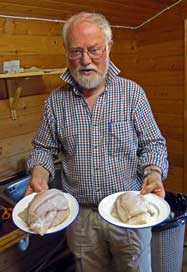 Utsjoki Lapinkylä Camping: we had
recollections from our last stay in 2012 of over-expensive prices, no wi-fi and
ill-mannered reception staff at Utsjoki Lapinkylä Camping. But things had changed
very much for the better: we were greeted by a smilingly helpful and welcoming
young lady at reception, wi-fi now covered the site, and the charge was €22.50
including SCC discount. We pitched on the grassy area opposite the facilities
huts with an open view to the surrounding fells (see right). Paul found every
pretext for putting off the moment of tackling the enormous cod lurking in the
bottom of its Berle Fisk plastic bag. Fortunately the campsite kitchen was
well-equipped, and taking a selection of knives, he set about the job of butchering the monster fish
(Photo
21 - Cod from Berleväg). Less than expertly (it has to be admitted), he
severed the fish from its king-sized backbone and cut it into portion sized
fillets, bagged up to provide us with 3 suppers, a tasty souvenir of our stay in Berlevåg
and the generosity of Berle Fisk (see left). At last we could relax after an eventful day
before cooking supper of cod freshly caught early this morning from the Barents
Sea. And we raised our glasses in thanks, wishing continued success to the
enterprising
Ludovic Besnard at Berle Fisk. Tonight back
in Northern Finland,
Berlevåg seemed a different universe, but with Utsjoki Lapinkylä Camping: we had
recollections from our last stay in 2012 of over-expensive prices, no wi-fi and
ill-mannered reception staff at Utsjoki Lapinkylä Camping. But things had changed
very much for the better: we were greeted by a smilingly helpful and welcoming
young lady at reception, wi-fi now covered the site, and the charge was €22.50
including SCC discount. We pitched on the grassy area opposite the facilities
huts with an open view to the surrounding fells (see right). Paul found every
pretext for putting off the moment of tackling the enormous cod lurking in the
bottom of its Berle Fisk plastic bag. Fortunately the campsite kitchen was
well-equipped, and taking a selection of knives, he set about the job of butchering the monster fish
(Photo
21 - Cod from Berleväg). Less than expertly (it has to be admitted), he
severed the fish from its king-sized backbone and cut it into portion sized
fillets, bagged up to provide us with 3 suppers, a tasty souvenir of our stay in Berlevåg
and the generosity of Berle Fisk (see left). At last we could relax after an eventful day
before cooking supper of cod freshly caught early this morning from the Barents
Sea. And we raised our glasses in thanks, wishing continued success to the
enterprising
Ludovic Besnard at Berle Fisk. Tonight back
in Northern Finland,
Berlevåg seemed a different universe, but with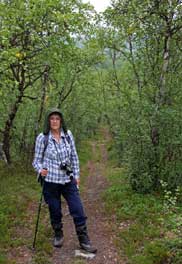 ever-fond recollections; we hoped the harbour extension would be completed
before winter sets in and would serve the town well.
ever-fond recollections; we hoped the harbour extension would be completed
before winter sets in and would serve the town well.
The Utsjoki Nature Trail: today we
planned to walk the Utsjoki Nature Trail up into the fells above
the village on the western side of the valley (Click here for map of Utsjoki Nature Trail).
Just along the road from the campsite, a signpost marked the start of several
trails leading up from Utsjoki into the fells including the 3.5 km nature
trail (luonto-polku in Finnish). The map shows clearly that the route
involved a significantly steep height gain up the wooded fell-side onto the high
plateau, and an equally steep descent down Annagurra gulley back into the
village.
The path was well way-marked, rising steeply up the fell-side which, being
located north of the taiga coniferous forest zone circling the northern
hemisphere, is covered with low mountain-birch. The midges and blackfly soon
became bothersome each time we stopped, forcing us to don midge-nets and cover
exposed arms, neck and face with DEET. The path wound ever steeply up the wooded
fell-side, gaining height quickly in a steady climb (see right). This was
a real Lapland paradise of wild flora with Twinflowers, Mountain Heath,
Lingonberry, Crowberry, Bilberry and Dwarf Cornel which were just beginning to
form embryonic
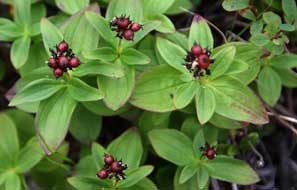 berries at the base of their florets
(see left). Information panels, with
English translation given in Metsähallitus leaflets, explained the post-glacial geological
features of the fell-land landscape, resulting from the retreat of the 2 kms
thick continental ice-sheet at the close of the last Ice Age 11,000 years ago.
The abrasive power of retreating glaciation eroded mineral materials from the
bed-rock such as gravel, sand, and clay particles; these mineral sediments mixed
with older soils were deposited on the bed-rock as a crushed mass of lodgement
till. The fell-side above Utsjoki was made up of this till soil laid down under
or at the leading edge of the ice-sheet. The path passed through a gate in a
reindeer fence which extended across the length of the fell-side. Alongside the
fence were classic example of huge erratic boulders, gouged from the bed-rock
by the powerful action of the continental ice-sheet and transported from their
point of origin further south, either within or under the ice as the glaciers
retreated; when the ice melted, the boulders were deposited on the basal till.
The start point from which they were removed from their parent rock, and the berries at the base of their florets
(see left). Information panels, with
English translation given in Metsähallitus leaflets, explained the post-glacial geological
features of the fell-land landscape, resulting from the retreat of the 2 kms
thick continental ice-sheet at the close of the last Ice Age 11,000 years ago.
The abrasive power of retreating glaciation eroded mineral materials from the
bed-rock such as gravel, sand, and clay particles; these mineral sediments mixed
with older soils were deposited on the bed-rock as a crushed mass of lodgement
till. The fell-side above Utsjoki was made up of this till soil laid down under
or at the leading edge of the ice-sheet. The path passed through a gate in a
reindeer fence which extended across the length of the fell-side. Alongside the
fence were classic example of huge erratic boulders, gouged from the bed-rock
by the powerful action of the continental ice-sheet and transported from their
point of origin further south, either within or under the ice as the glaciers
retreated; when the ice melted, the boulders were deposited on the basal till.
The start point from which they were removed from their parent rock, and the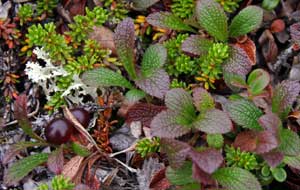 distance transported is unknown. In the Utsjoki valley, glacial rivers flowing
under the ice transported sand, gravel and other moraine materials, and
deposited them to form esker ridges in the bottom of melt-water tunnels. These
expanded and accumulated into sandy moraine deltas, later eroded to form river
valleys such as the Utsjoki and Teno valleys.
distance transported is unknown. In the Utsjoki valley, glacial rivers flowing
under the ice transported sand, gravel and other moraine materials, and
deposited them to form esker ridges in the bottom of melt-water tunnels. These
expanded and accumulated into sandy moraine deltas, later eroded to form river
valleys such as the Utsjoki and Teno valleys.
Our path continued up the steep slope among
mountain-birches, and gradually emerged
onto a more open, treeless fell-top plateau. Rising now above the tree-line, we
could look down and see in the misty distance the Utsjoki bridge and line of
the Teno River valley (Photo
22 - Utsjoki bridge). As the almost tree-less fell-side opened up, the
ground was covered with patches of Alpine Bearberry with ripening fruits (Photo
23 - Alpine Bearberry) just turning from green to red and some almost black-maroon fully ripe (see
right). The way-marked path
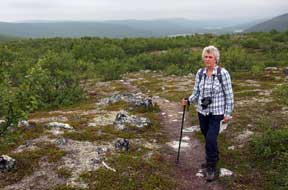 continued
through birch scrub still gaining a little height; this was an eerily lonely
place with little view of the terrain ahead, and we were thankful for trail
markers and an accurate, detailed map (see left). The path emerged eventually at
the Metsähallitus kota-hut by the small upland lake of
Kalgujokilampi which filled a fell-side hollow at
a meeting of paths. Here we began the descent which steepened into the Annagurra
gulley whose enclosed sides were covered with Dwarf Cornel and Twin Flowers
among the overhanging birches (Photo
24 - Annagurra gulley) (see below right). The path dropped in a series of steep steps down
the length of the gulley, a sheer delightful route for decent, to emerge just
above Utsjoki village school, from where a sandy track lined with shiny black
ripe Crowberries continued
through birch scrub still gaining a little height; this was an eerily lonely
place with little view of the terrain ahead, and we were thankful for trail
markers and an accurate, detailed map (see left). The path emerged eventually at
the Metsähallitus kota-hut by the small upland lake of
Kalgujokilampi which filled a fell-side hollow at
a meeting of paths. Here we began the descent which steepened into the Annagurra
gulley whose enclosed sides were covered with Dwarf Cornel and Twin Flowers
among the overhanging birches (Photo
24 - Annagurra gulley) (see below right). The path dropped in a series of steep steps down
the length of the gulley, a sheer delightful route for decent, to emerge just
above Utsjoki village school, from where a sandy track lined with shiny black
ripe Crowberries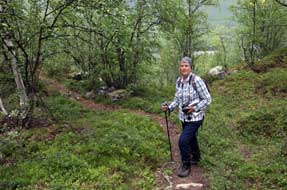 led back
along the road to the campsite.
led back
along the road to the campsite.
It's the time of year in the Arctic north when the
berries are ripening almost ready for berry-picking, and we have included a
picture gallery of
Wild Berries of The Arctic.
By the time we were back at camp, a warm sun was
shining. The forecast for severe rain tonight scarcely seemed credible, but by
5-30pm the sky progressively darkened and by 6-00pm the rain started. And did it
rain! The forecast given by the ever-reliable
Norwegian Meteorological Institute was again impressively precise, with over
5mm of rain falling in the first hour. The campsite ground and roadways were
soon waterlogged, with the rain driven by a chill Arctic wind. We cooked a
warming supper of another portion of Berlevåg cod as the rain poured all evening
- thoroughly miserable weather.
Utsjoki church huts:
the overnight rain had more or less left off this morning and the rain water
drained away on the gravelly ground. Breakfast was accompanied by irritatingly
persistent noise from nearby camping-cars; this increasingly regular nuisance
factor on campsites, with uncontrolled barking dogs, undue volume from TVs, and
inconsiderately over-loud conversation from people showing complete indifference
to the feeling of fellow campers is becoming an all too frequent problem,
reflecting the general absence of good manners and consideration for others
which bedevils contemporary society. Are we the only ones to feel so offended
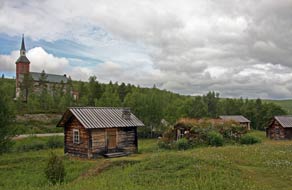 by
loutish behaviour? by
loutish behaviour?
Before moving on this morning, we drove 5 kms
south from the village to revisit the Utsjoki preserved church huts set
alongside Lake Mantojärvi opposite the 19th century Lutheran church up on the
fell-side. The present church built in 1850 replaced the former wooden church of
St Ulrika which was founded in 1700 to serve the far-flung parishioners of
Utsjoki both indigenous Sámi and Finnish settlers. People travelled vast
distances by boat, reindeer and sledge to attend church, market festivals and
tax collection, and would often arrive the previous day needing overnight lodging.
From the 18th century, a collection of wooden or turf huts grew up around the
church to provide accommodation for those families travelling from remote parts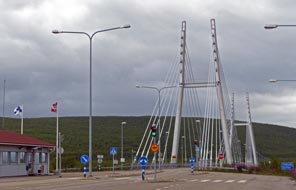 of the parish. 13 of these huts have been preserved on the lakeside opposite the
church (Photo
25- Utsjoki church huts). Just down the road the parsonage designed in 1843 by Engel is still the
official residence of the Utsjoki pastor. Over in the lakeside meadow the wild
flora was of as much interest as the huts: masses of juicy, ripe Crowberries,
ripening Lingonberries, and plants of Alpine Gentian its blue flowers now long past.
We walked around the church huts, and the natural beauty of the lakeside setting
combined with the sense of social history that the preserved huts represent made
this a memorable visit.
of the parish. 13 of these huts have been preserved on the lakeside opposite the
church (Photo
25- Utsjoki church huts). Just down the road the parsonage designed in 1843 by Engel is still the
official residence of the Utsjoki pastor. Over in the lakeside meadow the wild
flora was of as much interest as the huts: masses of juicy, ripe Crowberries,
ripening Lingonberries, and plants of Alpine Gentian its blue flowers now long past.
We walked around the church huts, and the natural beauty of the lakeside setting
combined with the sense of social history that the preserved huts represent made
this a memorable visit.
Back along to Utsjoki bridge, we pulled in
opposite the border post, where the customs officer (Tulli in Finnish) came over thinking we were a
cargo van ripe for inspection; he soon decided that not only were we
simple-minded tourists, but also ones that drove on the wrong-side of the road!
He
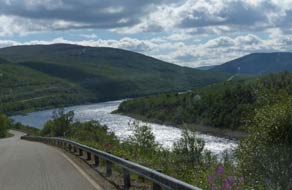 made friendly conversation but with an edge of duty: were we from England? how long had we been in
Finland? only 4 months; oh, so we lived here? no just travellers; we did not
fit his preconceived categories, but he allowed us to park in his customs bay to
photograph his border bridge
(Photo
26- Teno Bridge at Utsjoki) (see right). made friendly conversation but with an edge of duty: were we from England? how long had we been in
Finland? only 4 months; oh, so we lived here? no just travellers; we did not
fit his preconceived categories, but he allowed us to park in his customs bay to
photograph his border bridge
(Photo
26- Teno Bridge at Utsjoki) (see right).
Route 970 along the Teno River to Karigasniemi:
we turned off onto Route 970 which ran high above the Teno River for the 100 kms
drive down to Karigasniemi (click on Map 3 at top right of page). By now the
cloud was thinning and sun beginning to break through, the hazy sunlight
brightening the birch-covered fells on both sides of the river. Passing just the
occasional fishing shack, Route 970 gave glorious views along the length of the
Teno. The high, rolling birch-covered fells stretched away to the horizon,
broken only by narrow ribbon of the road's tarmac and the wide river flowing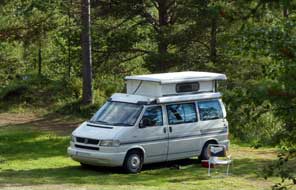 past
sandy banks (see left). Mile after endless mile we drove, following
the border-river with sunlight brightening the vista of empty fells. As we
advanced upstream, the river became wider and shallower, running amid
sand-banks. Towards Karigasniemi, the road dropped down to pass river-side farm
lands through a series of Sámi settlements: Nuvvos, Dálvados, Aittijoki,
Nuorpiniemi, Outakoski, Akukoski, Piesjoki, Rovisuvanto, finally reaching the
forested approach to Karigasniemi. It was 4-00pm by the time we finally turned
down to Tenorinne Camping after this afternoon's long drive. We settled onto the
past
sandy banks (see left). Mile after endless mile we drove, following
the border-river with sunlight brightening the vista of empty fells. As we
advanced upstream, the river became wider and shallower, running amid
sand-banks. Towards Karigasniemi, the road dropped down to pass river-side farm
lands through a series of Sámi settlements: Nuvvos, Dálvados, Aittijoki,
Nuorpiniemi, Outakoski, Akukoski, Piesjoki, Rovisuvanto, finally reaching the
forested approach to Karigasniemi. It was 4-00pm by the time we finally turned
down to Tenorinne Camping after this afternoon's long drive. We settled onto the
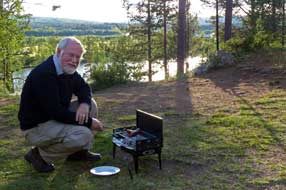 grassy terrace overlooking the river used several times previously, and up at
reception were greeted as always with welcoming hospitality by the son of the Lehtosalo family who had established Tenorinne Camping here back in 1966. After
a walk along to the K-Market in the village, we settled in and brewed tea,
looking out to the distant hill of Norway across the river. We were looking
forward to our day in camp here at Teno-rinne (meaning appropriately Teno
Banks) tomorrow. grassy terrace overlooking the river used several times previously, and up at
reception were greeted as always with welcoming hospitality by the son of the Lehtosalo family who had established Tenorinne Camping here back in 1966. After
a walk along to the K-Market in the village, we settled in and brewed tea,
looking out to the distant hill of Norway across the river. We were looking
forward to our day in camp here at Teno-rinne (meaning appropriately Teno
Banks) tomorrow.
A day in camp at Tenorinne Camping:
thinning cloud promised a fine day at last for our day in camp here at
Tenorinne (Photo
27 - Tenorinne Camping), always considered by us as one of Finland's finest campsites
(see above right). The sun broke
through for a truly relaxing day, before tomorrow's long drive.
With the mosquitoes now almost gone for this year, we celebrated by cleaning all
the smears from weeks of killing mossies from the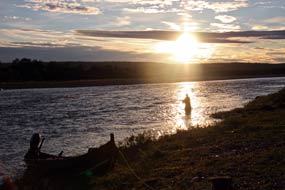 inner sides of George's
windows and giving his windscreen a thorough cleaning. That evening we enjoyed a
barbecue supper (see left), and as the sun
declined along the river at 9-30pm we walked down to the banks of the Teno
for sunset photos with the silhouette of a lone fisherman standing in the river
lit by the golden trail of the setting sun
(see right) (Photo
28 - Teno fisherman at sunset) inner sides of George's
windows and giving his windscreen a thorough cleaning. That evening we enjoyed a
barbecue supper (see left), and as the sun
declined along the river at 9-30pm we walked down to the banks of the Teno
for sunset photos with the silhouette of a lone fisherman standing in the river
lit by the golden trail of the setting sun
(see right) (Photo
28 - Teno fisherman at sunset)
A long cross-border drive through Karasjok,
across the Finnmarksvidda to Kautokeino:
we were up and away early, and although only August, the morning air had a
chillness with signs of approaching autumn. For today's long cross-border drive
beginning at Karigasniemi in Finland, we should cross back into Norway to Karasjok for
the 120
kms drive over the high Finnmarksvidda fells down to Kautokeino, cross back into
Finland at Enontekiö, and finally camp tonight at Karesuando, Sweden's
northernmost village (click on Maps 3 and 4 at top right of page). Leaving
Karigasniemi we crossed the border bridge
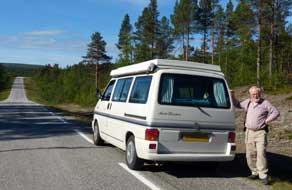 over the Teno to drive along the lower
stretches of the Karasjoki as it meandered through valley farm fields mown for
winter silage to reach Karasjok. Beyond the Old Church and across the river, we
turned off onto Route 92 past the Sámi Parliament to head out into wilderness terrain along the
pine-wooded middle Karasjoki river valley (see left). The sun was bright this
morning, lighting the distant wild fell-scape. The road followed the upper
valley of the tributary Lesjoki and, beyond the Sámi settlement of Jergol, began
the long climb into the empty wilderness of birch-scrub covered fells stretching
away to distant horizons. The river's over the Teno to drive along the lower
stretches of the Karasjoki as it meandered through valley farm fields mown for
winter silage to reach Karasjok. Beyond the Old Church and across the river, we
turned off onto Route 92 past the Sámi Parliament to head out into wilderness terrain along the
pine-wooded middle Karasjoki river valley (see left). The sun was bright this
morning, lighting the distant wild fell-scape. The road followed the upper
valley of the tributary Lesjoki and, beyond the Sámi settlement of Jergol, began
the long climb into the empty wilderness of birch-scrub covered fells stretching
away to distant horizons. The river's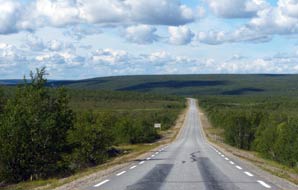 vast catchment area of marshes and lakes covered this open vista of fell-land,
over-arched by a dramatic cloud-scape (see right). The road gained further
height through the Sámi settlement of Suosjärvi, but so endless was the
fell-land that the expected watershed simply failed to arrive. The waters of
this empty wilderness plateau seemed to drain nowhere, but the map showed that
this vast catchment area of lakes and marshes was all still draining eastwards
into the Lesjoki and Karasjoki, eventually into the Teno/Tana and ultimately
into the Barents Sea.
vast catchment area of marshes and lakes covered this open vista of fell-land,
over-arched by a dramatic cloud-scape (see right). The road gained further
height through the Sámi settlement of Suosjärvi, but so endless was the
fell-land that the expected watershed simply failed to arrive. The waters of
this empty wilderness plateau seemed to drain nowhere, but the map showed that
this vast catchment area of lakes and marshes was all still draining eastwards
into the Lesjoki and Karasjoki, eventually into the Teno/Tana and ultimately
into the Barents Sea.
More height gain brought us to another Sámi
settlement, but only from the map could we distinguish the change to westward
draining water: the final lake of Lahpojärvi at last marked the watershed with
the lake-system now draining westwards into the Altaelva river, eventually to flow
out into Alta Fjord and the Norwegian Sea. Beyond the lake, the road descended
steeply to cross the valley river to the road
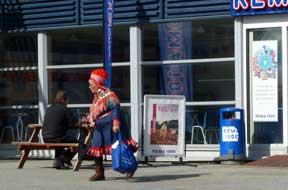 junction
with Route 93. Right was north to Alta and we turned south along the valley
towards Kautokeino. Passing the elongated river-lakes with their equally elongated
Sámi name of Gnovdageaineatnu, we reached Kautokeino and pulled into the Rema
1000 supermarket for our final Norwegian provisions shop this year. An elderly
lady in her traditional Sámi costume, bonnet and boots was just leaving the shop
to clamber into her pick-up to drive home to her lavvu (see left and below
right). Leaving Kautokeino, we began the 78 km drive to the Norwegian border and
back into Finland. By now the bright sun of earlier had given junction
with Route 93. Right was north to Alta and we turned south along the valley
towards Kautokeino. Passing the elongated river-lakes with their equally elongated
Sámi name of Gnovdageaineatnu, we reached Kautokeino and pulled into the Rema
1000 supermarket for our final Norwegian provisions shop this year. An elderly
lady in her traditional Sámi costume, bonnet and boots was just leaving the shop
to clamber into her pick-up to drive home to her lavvu (see left and below
right). Leaving Kautokeino, we began the 78 km drive to the Norwegian border and
back into Finland. By now the bright sun of earlier had given
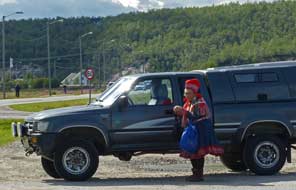 way
to gloomy cloud cover, giving the birch-covered fell-land a dull, grey, lifeless
appearance, with nothing to distinguish Norwegian from Finnish fell and
stone-fields after we had crossed the border. way
to gloomy cloud cover, giving the birch-covered fell-land a dull, grey, lifeless
appearance, with nothing to distinguish Norwegian from Finnish fell and
stone-fields after we had crossed the border.
Back into Finland at
Enontekiö and into Northern Sweden at Karesuando :
passing through forests of elegant pines and candle-spruces, we finally reached
the road junction at Enontekiö and turned along through the village, past the
modern church with its slender spire, for our Finnish food shopping at the
K-Market. Leaving Enontekiö we began the 62 km final stage of today's long
journey along to Karesuando and our third Nordic country of the day. The sky was
still dully overcast giving the forests a gloomy air. At the junction with Route
21/E8 we turned NW towards Kilpisjärvi. The road followed the winding Muonijoki
river which forms the border with Northern Sweden and which eventually merges
into the Toreälven to flow into the head of the Bothnian Gulf. Today we had
followed 3 different river systems each flowing into 3 different seas. Along
past Sámi settlements, we finally approached Kaaresuvanto on the Finnish side of
the river, and
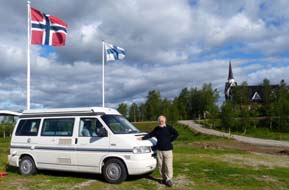 turned
across the border-bridge into Karesuando, Sweden's northernmost village at the
top of the E45 Inlandsvägen. turned
across the border-bridge into Karesuando, Sweden's northernmost village at the
top of the E45 Inlandsvägen.
Sandlövs Camping at Karesuando:
although having travelled through Northern Norway today, we were planning to
return to Finland tomorrow for Kilpisjärvi, and despite all the changes of time
zones today and tonight, we kept our watches on Finnish time for our overnight
camp in Sweden tonight. Having checked the weather forecast using Karesuando
TIC's wi-fi, we drove over to Sandlövs Camping on the corner opposite the church
and pitched at the end nearest the TIC in the hope that their wi-fi would reach
across the road. Although straightforward with rustic facilities, Sandlövs
Camping is a lovely site set right opposite Laestradius' church by the
Karesuando bridge, and always makes an enjoyable stay (see left); we booked in with the
gentle elderly owner
(Photo
29 - Sandlövs Camping). Just one other camper arrived tonight and after
today's 260 km drive, we had this lovely spot almost to ourselves.
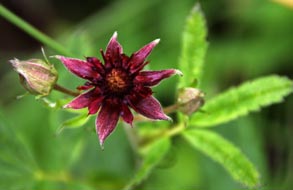 Finland's remote NW corner out at Kilpisjärvi:
having checked the forecast again this morning, our planned visit to the
Treriksröset Three Borders Cairn was rescheduled to fit in with better weather
tomorrow. We re-crossed the Muoniojoki bridge into Finland to resume our drive
out to Kilpisjärvi, at the tip of Finland's remote NW salient. We had 2 planned
stops on the long drive both of which we had learnt of from the ever-useful
Crossbill Guide to Finnish Lapland. The first of these was the Markkina
bird-watching tower 5 kms along E8 north of Kaaresuvanto. A board-walk led for
some 300m along the banks of the Muoniojoki, where the marshy ground
supported flourishing patches of Marsh Cinquefoil with its garishly dusky maroon
star-shaped flowers (see right) and banks of Dwarf Cornel the berries now fully
formed. The wooden tower overlooked the wide river on one side and a broad area
of aapa marshes beyond the road. In May the area teems with waders and cranes,
but in mid-August there was no bird-life to be seen. Resuming our drive, we
crossed the broad tributary River Lätäseno which drains the desolate fell-land
wilderness of NW Finland. The lonely E8 road followed the course of the
Muoniojoki stretching endlessly across fell-scape, empty and uninhabited
save for the occasional Sámi reindeer-herding settlement. This desolate
landscape and distant higher fells was lit by today's sun to relieve the gloom. Finland's remote NW corner out at Kilpisjärvi:
having checked the forecast again this morning, our planned visit to the
Treriksröset Three Borders Cairn was rescheduled to fit in with better weather
tomorrow. We re-crossed the Muoniojoki bridge into Finland to resume our drive
out to Kilpisjärvi, at the tip of Finland's remote NW salient. We had 2 planned
stops on the long drive both of which we had learnt of from the ever-useful
Crossbill Guide to Finnish Lapland. The first of these was the Markkina
bird-watching tower 5 kms along E8 north of Kaaresuvanto. A board-walk led for
some 300m along the banks of the Muoniojoki, where the marshy ground
supported flourishing patches of Marsh Cinquefoil with its garishly dusky maroon
star-shaped flowers (see right) and banks of Dwarf Cornel the berries now fully
formed. The wooden tower overlooked the wide river on one side and a broad area
of aapa marshes beyond the road. In May the area teems with waders and cranes,
but in mid-August there was no bird-life to be seen. Resuming our drive, we
crossed the broad tributary River Lätäseno which drains the desolate fell-land
wilderness of NW Finland. The lonely E8 road followed the course of the
Muoniojoki stretching endlessly across fell-scape, empty and uninhabited
save for the occasional Sámi reindeer-herding settlement. This desolate
landscape and distant higher fells was lit by today's sun to relieve the gloom.
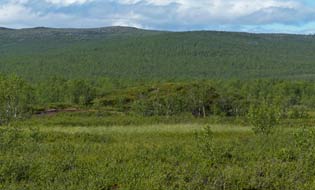 Palsa mires: some 50 kms further, just before the Sámi hamlet of Iitto,
we reached today's second nature stop at an example of Palsa mires, large
hummocky hillocks of peat overlying a permanently frozen peaty core within the
permafrost, rising up within the surrounding wet peatland marshes. These are
formed during bitterly cold, dry winters when the frozen core expands pushing
the surface peat upwards and raising the mounds to a height of over 5m. The
unfrozen surface layer of peat acts as an insulating blanket preserving
the frozen core. A board-walk circled around the edge of the mire giving clear
views of a number of Palsa mire mounds (Photo
30 - Palsa mires) in different stages of evolution: embryonic mounds just developing, those
where the core was melting, and Palsas which Palsa mires: some 50 kms further, just before the Sámi hamlet of Iitto,
we reached today's second nature stop at an example of Palsa mires, large
hummocky hillocks of peat overlying a permanently frozen peaty core within the
permafrost, rising up within the surrounding wet peatland marshes. These are
formed during bitterly cold, dry winters when the frozen core expands pushing
the surface peat upwards and raising the mounds to a height of over 5m. The
unfrozen surface layer of peat acts as an insulating blanket preserving
the frozen core. A board-walk circled around the edge of the mire giving clear
views of a number of Palsa mire mounds (Photo
30 - Palsa mires) in different stages of evolution: embryonic mounds just developing, those
where the core was melting, and Palsas which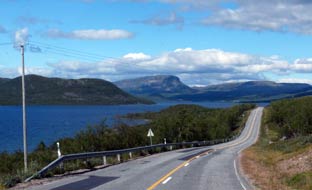 had collapsed leaving just a
flooded pit. At the far end of the board-walk we could examine the Palsas at
close range where the surface of surrounding peat was dry and crunchy.
Cloudberries flourished on the marshy peat alongside the board-walk and it was
the time of year when the fruit should be ripening; either it was a poor summer
for Cloudberries or they had all been picked. had collapsed leaving just a
flooded pit. At the far end of the board-walk we could examine the Palsas at
close range where the surface of surrounding peat was dry and crunchy.
Cloudberries flourished on the marshy peat alongside the board-walk and it was
the time of year when the fruit should be ripening; either it was a poor summer
for Cloudberries or they had all been picked.
Kilpisjärvi Retkeilykeskus (Trekking Centre): from a high point
overlooking Kilpisjärvi, the road descended steeply giving an extensive panorama
along the length of the lake with the distant backdrop fells (see right). The
Metsähallitus Information Centre at Kilpisjärvi confirmed times of the boat
across the lake for the trek out to the Treriksröset tomorrow; we topped up our
provisions at the K-Market (well-stocked for Norwegian cross-border shoppers),
and continued along to Kilpisjärvi Retkeilykeskus (Trekking Centre),
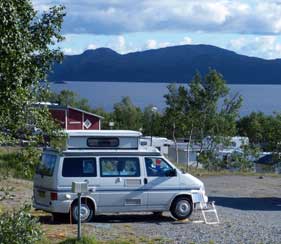 slowing for
reindeer to trot across the main road
(Photo 31 - Reindeer at Kilpisjärvi).
The campsite tiered up the steep slopes of Saana Fell is geared to the ski
trade, with wooden 'sheds' to which caravans are attached in winter; in summer
these are all deserted and the grassless terraces rather austere. But the staff
are welcoming and helpful and the outlook across the lake is glorious (Photo
32- Kilpisjärvi Retkeilykeskus) (see left). The higher terraces of the camping area, where we had previously camped, had
plenty of space among the now deserted winter caravan sheds and we camped up
here; the afternoon sunshine was bright and warm, lighting the magnificent view
across Kilpisjärvi with the snow-covered Swedish and Norwegian mountains rising
beyond and the nearer peak of Malla Fjell at the lake's northern end. Behind us
the craggy cliffs of the 1,000m high Saana Fell rose sheer (see right). During
the afternoon the sound of a reindeer bell announced slowing for
reindeer to trot across the main road
(Photo 31 - Reindeer at Kilpisjärvi).
The campsite tiered up the steep slopes of Saana Fell is geared to the ski
trade, with wooden 'sheds' to which caravans are attached in winter; in summer
these are all deserted and the grassless terraces rather austere. But the staff
are welcoming and helpful and the outlook across the lake is glorious (Photo
32- Kilpisjärvi Retkeilykeskus) (see left). The higher terraces of the camping area, where we had previously camped, had
plenty of space among the now deserted winter caravan sheds and we camped up
here; the afternoon sunshine was bright and warm, lighting the magnificent view
across Kilpisjärvi with the snow-covered Swedish and Norwegian mountains rising
beyond and the nearer peak of Malla Fjell at the lake's northern end. Behind us
the craggy cliffs of the 1,000m high Saana Fell rose sheer (see right). During
the afternoon the sound of a reindeer bell announced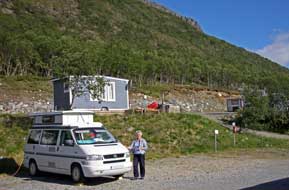 the arrival of the reindeers
that graze the site, and a large buck trotted past sprouting a regal set of
antlers. That evening the sun declined across the lake with dramatically
promising flare towards Malla Fjell, but at the last minute set into a dense
bank of cloud.
the arrival of the reindeers
that graze the site, and a large buck trotted past sprouting a regal set of
antlers. That evening the sun declined across the lake with dramatically
promising flare towards Malla Fjell, but at the last minute set into a dense
bank of cloud.
A trek to the Treriksröset Three Borders Cairn: after a very cold
night camped on this exposed mountain side, we woke to a heavily overcast
sky with the temperature inside the camper down to 11°C. The boat across Kilpisjärvi
for the trek to the Treriksröset monument was not until 2-00pm so we had a
morning in camp. Facilities at Kilpisjärvi Retkeilykeskus were mixed: being
geared to winter trade, the campsite's WC/showers were modern, clean and heated, most welcome in this chill weather, but the kitchen/wash-up in a dilapidated hut
was antiquated. A final check on the forecast showed the weather continuing
overcast but with no rain and even a hint of sun mid afternoon just when we
needed it. The same antiquated boat M/S Malla was waiting down at the
landing stage just opposite the campsite
(Photo
33 - M/S Malla), and was already quite full of fell-walkers. We
boarded to wait for the same grumpy old boatman to come round and collect the
€25 return fares. The cloud was heavier than ever with a brisk wind blowing from
across the lake, raising spray as the boat chugged across to the inlet on the
far NW corner of Kilpisjärvi lake.
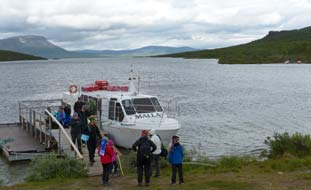 The boat docked at 2-30pm on a headland just into
Swedish territory where the stream marking the Swedish~Finnish border enters the
lake, and we now had 2 hours
for the 6 km round-trip trek out and back on the fell-land path before the boat
returned across Kilpisjärvi at 4-30pm (Click here for map of trek to the Treriksröset).
Recalling timings from our last visit in 2012, this meant 45 minutes for the
outward walk, 30 minutes exploring around the Treriksröset monument, leaving 45
minutes for the 3 km return walk. The well-trodden track, muddy in places after
recent rains with some board-walks, followed the line of the border reindeer
fence, and the water course flowing down into Kilpisjärvi Lake which marked the
actual line of the Finnish~Swedish border. The path therefore passed along the
Swedish side of the frontier. There was no time to pause to admire the flora,
and we kept up a brisk pace with one eye on the map and the other on watches,
covering the first kilometre in 15 minutes and reaching the area of the 3
borders meeting point by 3-15pm. The boat docked at 2-30pm on a headland just into
Swedish territory where the stream marking the Swedish~Finnish border enters the
lake, and we now had 2 hours
for the 6 km round-trip trek out and back on the fell-land path before the boat
returned across Kilpisjärvi at 4-30pm (Click here for map of trek to the Treriksröset).
Recalling timings from our last visit in 2012, this meant 45 minutes for the
outward walk, 30 minutes exploring around the Treriksröset monument, leaving 45
minutes for the 3 km return walk. The well-trodden track, muddy in places after
recent rains with some board-walks, followed the line of the border reindeer
fence, and the water course flowing down into Kilpisjärvi Lake which marked the
actual line of the Finnish~Swedish border. The path therefore passed along the
Swedish side of the frontier. There was no time to pause to admire the flora,
and we kept up a brisk pace with one eye on the map and the other on watches,
covering the first kilometre in 15 minutes and reaching the area of the 3
borders meeting point by 3-15pm.
The original monument had been erected in 1897
when a border commission between Imperial Russia and the Kingdom of Sweden had defined the exact border line between Sweden and the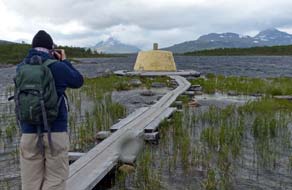 Grand Duchy of
Finland and Norway which the two Great Powers controlled. Norway gained its
independent statehood in 1905 and put up its own smaller monument; Finland
finally secured its independence from Russia after the Bolshevik revolution in
1917 and the current Three Countries Cairn was erected in 1926, 9 years after
Finland's independence. The border lines in this remote NW corner were
consolidated between the 3 now independent states. Grand Duchy of
Finland and Norway which the two Great Powers controlled. Norway gained its
independent statehood in 1905 and put up its own smaller monument; Finland
finally secured its independence from Russia after the Bolshevik revolution in
1917 and the current Three Countries Cairn was erected in 1926, 9 years after
Finland's independence. The border lines in this remote NW corner were
consolidated between the 3 now independent states.
We clambered through the reindeer fence and out
onto the board-walk towards the Treriksröset cairn set on an islet in Lake Goldajärvi.
Given its significance, it really is an ungainly, inelegant monster of
a monument: an enormous yellow-painted concrete conical object with the
board-walk extending around it. The monument's setting however more than makes
up for its unattractive appearance: looking across the board-walk, the conical
stone was backed by a magnificent panorama of snow-capped
peaks on the distant Norwegian sky-line
(Photo
34 - Treriksröset monument). The sky was heavily overcast with a
dramatically grey cloud-scape and a brisk north-westerly wind ruffling the lake
surface and driving spray onto our camera lens. In this wind, it was also a
precarious walk around the yellow cone to circle the board-walk through the 3
countries' coincidence of borders; and as we withdrew along the board-walk,
this moment marked the beginning of our long southward journey home.
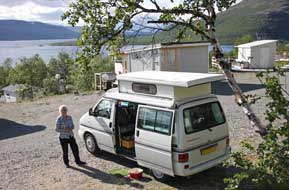 We kept up a brisk pace for the return walk,
crossing the final peaty mound at 4-25pm, and as we descended to the lake shore,
only at the last moment did the boat landing appear tucked away in a hollow.
Thankfully and rather out of breath, we clambered aboard and the boatman steered M/S Malla
away from the landing-stage to re-cross the lake with the sky brighter and
the brisk NW wind now behind us. We had been fortunate with weather this
afternoon: although gloomily overcast, there had been no rain, and despite the
NW wind, not as chill as feared. Back at the Kilpisjärvi landing-stage, we
plodded wearily back up to the campsite and stowed our kit, and a late afternoon
sun We kept up a brisk pace for the return walk,
crossing the final peaty mound at 4-25pm, and as we descended to the lake shore,
only at the last moment did the boat landing appear tucked away in a hollow.
Thankfully and rather out of breath, we clambered aboard and the boatman steered M/S Malla
away from the landing-stage to re-cross the lake with the sky brighter and
the brisk NW wind now behind us. We had been fortunate with weather this
afternoon: although gloomily overcast, there had been no rain, and despite the
NW wind, not as chill as feared. Back at the Kilpisjärvi landing-stage, we
plodded wearily back up to the campsite and stowed our kit, and a late afternoon
sun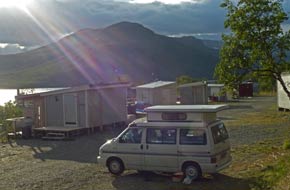 managed to break through to brighten the dreary hill-side
(see left) (Photo
35 - Late afternoon sun). That evening however the chill Arctic wind
increased buffeting the camper on this exposed hill-side where we were camped. managed to break through to brighten the dreary hill-side
(see left) (Photo
35 - Late afternoon sun). That evening however the chill Arctic wind
increased buffeting the camper on this exposed hill-side where we were camped.
Return to Sandlövs Camping at Karesuando: after
another cold and windy night, we woke to a gloomily overcast morning. But the chill
NW wind kept the clouds moving with the sky-scape ever-changing from threatening
dark to silver-grey with shafts of sunlight streaking though (Photo
36 - Dramatic sky at Kilpisjärvi) (see right). Setting off for the return
drive along the Kökämajoki valley, the wide, open vista of dreary grey-green
fells and stonefields was over-topped by a silver-grey sky, with the narrow
tarmac ribbon of Route 21/E8 undulating its straight course into the far
distance (see below left). Passing only the occasional truck, Norwegian
caravan and ambling reindeer (see below left), we made our
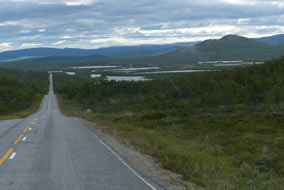 way
back across this empty wilderness following the river border until, eventually
crossing the Lätäseno River, we reached the area of birch-scrub on the approach
to Kaaresuvanto. Crossing the border-bridge into Ruotsi (as the Finns call
Sweden), we pulled into Sandlövs Camping, paid the 150 SEK for our second
night's stay and settled in with the chill wind still blowing down the valley.
By 6-30 that evening the Norwegian convoys began rolling in, and before long we
were hemmed in between the metallic canyon walls of monster camping-cars on both
sides, obliterating our light and view across to Karesuando church. At such
close quarters, the exaggerated size of these ludicrous pantechnicons simply
left us aghast with contempt that couples should choose to travel in such
ostentatious, way
back across this empty wilderness following the river border until, eventually
crossing the Lätäseno River, we reached the area of birch-scrub on the approach
to Kaaresuvanto. Crossing the border-bridge into Ruotsi (as the Finns call
Sweden), we pulled into Sandlövs Camping, paid the 150 SEK for our second
night's stay and settled in with the chill wind still blowing down the valley.
By 6-30 that evening the Norwegian convoys began rolling in, and before long we
were hemmed in between the metallic canyon walls of monster camping-cars on both
sides, obliterating our light and view across to Karesuando church. At such
close quarters, the exaggerated size of these ludicrous pantechnicons simply
left us aghast with contempt that couples should choose to travel in such
ostentatious,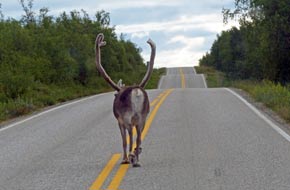 materialistic intemperance.
materialistic intemperance.
Over-expensive Hetan Lomakylä-Camping at Enontekiö:
the weather forecast for the coming week promised the beginning of a Ruska
Indian Summer, but it had not arrived yet; we woke to another grey and overcast
morning. Or perhaps the outside world was in fact enjoying sunshine which we
were unable to see being confined between the overshadowing walls of monster
camping-cars. By the time we had completed our washing-up and showers, the
pantechnicons had departed back to Norway, restoring our daylight and view of Laestadius' church. Re-crossing the Muoniojoki bridge into Finland, we turned SE
following the river-border. At a road-side Sámi food-stall, the smoked
fish and tubs of freshly picked cloudberries all looked attractive, but the
prices were geared to Norwegian cross-border affluence, certainly beyond our
pocket! The sun was desperately trying but not succeeding to break through the
cloud cover. Continuing through the
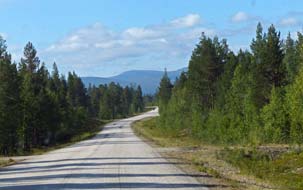 forests to Palojuensuu, we turned off onto
Route 93 back to Enontekiö. After a call at the ever-helpful Pallas-Yllästunturi
National Park Information Centre and the village K-Market for provisions, we
booked in Hetan Lomakylä-Camping near Ounasjärvi lake. The cost had risen from an already expensive
€23/night in 2012 to €26 today for what was a mediocre campsite; our comment on
an 8% increase in charges was met with a shrug of indifference, with prices
matched more to Norwegian affluence, or was it just simply greed. We settled in to
the upper camping area to be within reach of the wi-fi; by now the sky had fully
cleared and bright sun shining, and at last the mossies had gone - almost! The
evening remained clear as the sun set around 10-00pm. forests to Palojuensuu, we turned off onto
Route 93 back to Enontekiö. After a call at the ever-helpful Pallas-Yllästunturi
National Park Information Centre and the village K-Market for provisions, we
booked in Hetan Lomakylä-Camping near Ounasjärvi lake. The cost had risen from an already expensive
€23/night in 2012 to €26 today for what was a mediocre campsite; our comment on
an 8% increase in charges was met with a shrug of indifference, with prices
matched more to Norwegian affluence, or was it just simply greed. We settled in to
the upper camping area to be within reach of the wi-fi; by now the sky had fully
cleared and bright sun shining, and at last the mossies had gone - almost! The
evening remained clear as the sun set around 10-00pm.
Pyhäjoki Nature Trail in Pallas-Yllästunturi National Park:
the clear sky produced a chill night, but this morning we were woken by the
unfamiliar phenomenon of warming sun. Through Enontekiö, we continued ahead on
Route 965 through delightful forested sandy heath-land (so archetypally Finnish
Lapland) (click on Maps 4 and 5 at top right of page). Passing through the Sámi
hamlet of Vuontisjärvi, the road swung SW through more open farming countryside
with the distant Pallas-Yllästunturi high fells gracing the southern sky-line
(see above left). At the next village of Peltovuoma, Route 957 swung SW through
further forested terrain to cross the now wide and fast-flowing Ounasjoki river
(see right). We paused here for photos but Paul's camera lens, which had been
giving trouble for the past 2 weeks, now seized up
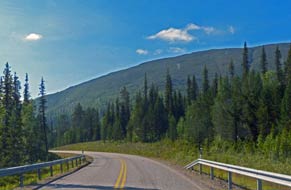 totally. It was precisely
this Sunday that we had passed this way 3 years ago in 2012, when we had seen
the snow-pole setting lorry at work. This year however, despite such a
disappointing summer, the birches were still fully green with not a trace of
Ruska gold
colours; the snow-poles would not be needed for a while yet. This morning's
sunshine lit the surrounding forests, casting long shadows of the tall
candle-spruces, making the drive along this deserted road a sheer delight (see
above left). As we headed along the Ounasjoki valley, candle-spruces
increasingly became the predominant trees with their elegant profiles
silhouetted against the clear blue sky (see left) We also passed a number of
reindeer trotting along the road (Photo
37 - Passing reindeer). totally. It was precisely
this Sunday that we had passed this way 3 years ago in 2012, when we had seen
the snow-pole setting lorry at work. This year however, despite such a
disappointing summer, the birches were still fully green with not a trace of
Ruska gold
colours; the snow-poles would not be needed for a while yet. This morning's
sunshine lit the surrounding forests, casting long shadows of the tall
candle-spruces, making the drive along this deserted road a sheer delight (see
above left). As we headed along the Ounasjoki valley, candle-spruces
increasingly became the predominant trees with their elegant profiles
silhouetted against the clear blue sky (see left) We also passed a number of
reindeer trotting along the road (Photo
37 - Passing reindeer).
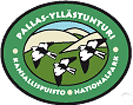 Reaching Pallasjärvi lake, we pulled into the
parking area for the Pyhäjoki Nature Trail. Such navigational precision after an
80 km drive, accurately plotting a precise spot in the midst of featureless
wilderness forests with the aid of sat-nav and GPS latitude/longitude
coordinates, was so satisfying. We booted up and set off to walk the 3.5 km
circuit through these lovely spruce forests of Pallas-Yllästunturi National
Park (Click here for map of Pyhäjoki Nature Trail). The national park's emblem (see right) incorporates
Snow Buntings
which breed on the open fells of Northern
Lapland. The path followed the lower course of the fast-running Pyhäjoki brook
through herb-rich spruce forest, but at this time of year all the wild flora
was well past. Across the first wooden foot-bridge, the path passed through a
lush grove of Ostrich Fern, and beyond the second bridge began to gain height.
So far the Bilberry ground-cover had few berries, all green and unripe. On this
more open slope however, Reaching Pallasjärvi lake, we pulled into the
parking area for the Pyhäjoki Nature Trail. Such navigational precision after an
80 km drive, accurately plotting a precise spot in the midst of featureless
wilderness forests with the aid of sat-nav and GPS latitude/longitude
coordinates, was so satisfying. We booted up and set off to walk the 3.5 km
circuit through these lovely spruce forests of Pallas-Yllästunturi National
Park (Click here for map of Pyhäjoki Nature Trail). The national park's emblem (see right) incorporates
Snow Buntings
which breed on the open fells of Northern
Lapland. The path followed the lower course of the fast-running Pyhäjoki brook
through herb-rich spruce forest, but at this time of year all the wild flora
was well past. Across the first wooden foot-bridge, the path passed through a
lush grove of Ostrich Fern, and beyond the second bridge began to gain height.
So far the Bilberry ground-cover had few berries, all green and unripe. On this
more open slope however,
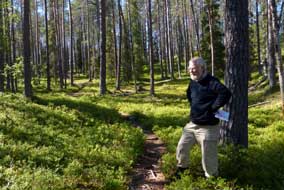 where sunlight filtered down through the trees, we
reached banks of Bilberry with masses of ripe berries. Recalling our successful
berry-picking here in 2012, we had brought plastic pots today and set to
gathering Bilberries for breakfast (Photo
38 - Bilberry picking). where sunlight filtered down through the trees, we
reached banks of Bilberry with masses of ripe berries. Recalling our successful
berry-picking here in 2012, we had brought plastic pots today and set to
gathering Bilberries for breakfast (Photo
38 - Bilberry picking).
As we gained height up the forested slope, spruce
were replaced by pines (see left) and the path contoured round the steep-sided
hill to cross one of Pyhäjoki's side-steams. The route now dropped down the
craggy slope to reach the point where the
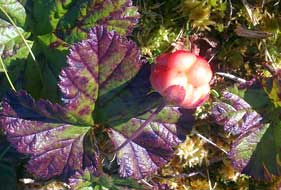 Pyhäjoki emerged from a
dark pool within a
mountain hollow, the waters sparkling in the afternoon sunshine as they
descended from their gathering areas high on the Pallas-Yllästunturi fells (Photo
39 - Pyhäjoki brook). The Pyhäjoki brook tumbled from the pool, crashing
down into a rocky gorge to flow down through the spruce forests we had passed
through earlier. Our path mounted the craggy slope and continued ahead
through the higher spruce forest, to emerge into more open marshy meadows which
it crossed on a board-walk. It was here in 2012 that we had found ripening
Cloudberries. There were still plenty of Cloudberry leaves alongside the
board-walk, but with such a poor summer this year, we were not expecting to find
any fruit. Part-way across however we began seeing reddish-orange berries,
partially ripe but still not quite ripe enough for gathering. But then we found
a few fruits that were fully ripe and soft, ready for eating (Photo
40 - Ripe Cloudberry fruit) (see ripe); Cloudberry fruit has a very
distinctive taste, almost honey-like with a smooth texture and large, hard
seeds. We continued across the hay meadows hoping to gather Juniper berries for
our cooking stocks but, unlike 2012 the berries this year were all green and
unripe showing not a hint of their blue ripening. Despite this disappointment,
today's berry picking of Bilberry and Cloudberry had been profitable. Pyhäjoki emerged from a
dark pool within a
mountain hollow, the waters sparkling in the afternoon sunshine as they
descended from their gathering areas high on the Pallas-Yllästunturi fells (Photo
39 - Pyhäjoki brook). The Pyhäjoki brook tumbled from the pool, crashing
down into a rocky gorge to flow down through the spruce forests we had passed
through earlier. Our path mounted the craggy slope and continued ahead
through the higher spruce forest, to emerge into more open marshy meadows which
it crossed on a board-walk. It was here in 2012 that we had found ripening
Cloudberries. There were still plenty of Cloudberry leaves alongside the
board-walk, but with such a poor summer this year, we were not expecting to find
any fruit. Part-way across however we began seeing reddish-orange berries,
partially ripe but still not quite ripe enough for gathering. But then we found
a few fruits that were fully ripe and soft, ready for eating (Photo
40 - Ripe Cloudberry fruit) (see ripe); Cloudberry fruit has a very
distinctive taste, almost honey-like with a smooth texture and large, hard
seeds. We continued across the hay meadows hoping to gather Juniper berries for
our cooking stocks but, unlike 2012 the berries this year were all green and
unripe showing not a hint of their blue ripening. Despite this disappointment,
today's berry picking of Bilberry and Cloudberry had been profitable.
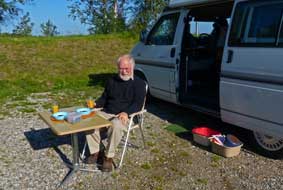 South
to Kittilä and Kittilän Lomamökit-Camping: down past Jerisjärvi, we
joined the main Route 79 expecting in the bright sunlight to see the beginnings
of Ruska golden colours on the birches as in 2012, but this year they still
showed untainted summer green. Even so this was a good road, surprisingly quiet
and passing through magnificent spruce forests which extended in an uninterrupted
vista of trees over distant fells. The frequent elk warning signs did however
cause us to be wary on the approach to Kittilä. This small town's buildings are
all blandly modern after the total devastation left behind by retreating Germans
in late 1944, and the evacuation of the town's civilian population to Sweden as
we had seen at Gällivare museum in 2013. We turned off across the now wide
Ounasjoki river to Kittilän Lomamökit-Camping, and settled into the gravelled
camping area behind the flood levée on the banks of the Ounasjoki river where the
supposed wi-fi signal was just about detectable. That evening the sun declined
along the river and set at 10-00pm leaving the sky with a ruddy glow. South
to Kittilä and Kittilän Lomamökit-Camping: down past Jerisjärvi, we
joined the main Route 79 expecting in the bright sunlight to see the beginnings
of Ruska golden colours on the birches as in 2012, but this year they still
showed untainted summer green. Even so this was a good road, surprisingly quiet
and passing through magnificent spruce forests which extended in an uninterrupted
vista of trees over distant fells. The frequent elk warning signs did however
cause us to be wary on the approach to Kittilä. This small town's buildings are
all blandly modern after the total devastation left behind by retreating Germans
in late 1944, and the evacuation of the town's civilian population to Sweden as
we had seen at Gällivare museum in 2013. We turned off across the now wide
Ounasjoki river to Kittilän Lomamökit-Camping, and settled into the gravelled
camping area behind the flood levée on the banks of the Ounasjoki river where the
supposed wi-fi signal was just about detectable. That evening the sun declined
along the river and set at 10-00pm leaving the sky with a ruddy glow.
We woke to a gloriously sunny morning and
virtually midge-free at last, and we celebrated with breakfast outside on the
river bank with bilberries picked yesterday at Pyhäjoki (see above left). Apart
from the distant sound of traffic on the Sodankylä road, it was a lovely
peaceful morning for our day in camp here. Facilities at Kittilän Lomamökit-Camping
had been improved since our last stay here in 2012 but not sufficiently to
justify the undue increase in prices to €25. The weather remained gloriously
sunny, and we ended the afternoon sat with a beer up on the levée looking out
across the Ounasjoki.
We shall continue our southward journey firstly
visiting Santa at his Office near to Rovaniemi, enjoy walking and a wild-camp in
the Napapiiri Hiking Area, visit Kemijärvi and the Auttiköngäs and Hepoköngäs
waterfalls, south to Oulu our favourite Finnish city, stay at a couple of our
favourite Finnish campsite at Matkatupa and Ristijärvi, and enjoy a peaceful
stay and make new friends at Vuokatinranta Camping near the ski-resorts of
Sotkamo and Voukatti. But that is all for the
next edition which will be published soon.
Next edition
to be published shortly
|
Sheila and Paul |
Published: 5 February 2016 |
|

 CAMPING
IN NORTHERN NORWAY and FINLAND 2015 - Kirkenes, Øvre
Pasvik Valley, Varanger Fjord and Vestre Jakobselv, Berlevåg, Utsjoki, Karigasniemi, Kautokeino, Karesuando
in Northern Sweden,
Kilpisjärvi and Treriksröset,
Enontekiö, Pyhäjoki, Kittilä:
CAMPING
IN NORTHERN NORWAY and FINLAND 2015 - Kirkenes, Øvre
Pasvik Valley, Varanger Fjord and Vestre Jakobselv, Berlevåg, Utsjoki, Karigasniemi, Kautokeino, Karesuando
in Northern Sweden,
Kilpisjärvi and Treriksröset,
Enontekiö, Pyhäjoki, Kittilä: Kirkenes: the rain had eased but the air was still
gloomy, and as we drove into the town, large numbers of parked cars and
closed streets barred our way. We were diverted down to the harbour road where
we managed to find the last of the parking, and walked up into the centre;
streets were filled with stalls and clearly the whole of Kirkenes was en fête
despite the wretched weather; it all seemed totally surrealistic! (
Kirkenes: the rain had eased but the air was still
gloomy, and as we drove into the town, large numbers of parked cars and
closed streets barred our way. We were diverted down to the harbour road where
we managed to find the last of the parking, and walked up into the centre;
streets were filled with stalls and clearly the whole of Kirkenes was en fête
despite the wretched weather; it all seemed totally surrealistic! ( Into
the Øvre
Pasvik Valley: back at Hesseng we turned off onto Route 885, the road which leads down into the Øvre
Pasvik Valley, that remote and curiously anomalous southward projecting salient of Norwegian territory
wedged between the Russian Oblast of Murmansk on the Petsamo peninsula and the remote NE area
of Finland around Lake Inarijärvi (
Into
the Øvre
Pasvik Valley: back at Hesseng we turned off onto Route 885, the road which leads down into the Øvre
Pasvik Valley, that remote and curiously anomalous southward projecting salient of Norwegian territory
wedged between the Russian Oblast of Murmansk on the Petsamo peninsula and the remote NE area
of Finland around Lake Inarijärvi ( turning off to Høyde 96, the Cold War former military lookout tower; in this poor visibility
the mist would obscure even the river let alone the town of
Nikel which is normally shrouded with smoky emissions from the smelting works
which dominate the town (see left). Today we continued ahead, bumping our way
along the narrow road through endless forest lands passing occasional
farmsteads, sometimes closely alongside the river-border, sometimes further
inland. When we could see the river, the misty Russian territory on the far bank
looked even more gloomily uninviting than ever. On and on the road wound,
shoulder-achingly rutted, with just the occasional local passing car as we
bumped along past the wider water where the Pasvik River swelled out into
Vaggatem Lake. Hay drying racks stretched along the lake shore as we approached
the village of Vaggatem, just a handful of farmsteads, the descendents of the
original settlers sponsored by the Norwegian government to populate this
isolated valley.
turning off to Høyde 96, the Cold War former military lookout tower; in this poor visibility
the mist would obscure even the river let alone the town of
Nikel which is normally shrouded with smoky emissions from the smelting works
which dominate the town (see left). Today we continued ahead, bumping our way
along the narrow road through endless forest lands passing occasional
farmsteads, sometimes closely alongside the river-border, sometimes further
inland. When we could see the river, the misty Russian territory on the far bank
looked even more gloomily uninviting than ever. On and on the road wound,
shoulder-achingly rutted, with just the occasional local passing car as we
bumped along past the wider water where the Pasvik River swelled out into
Vaggatem Lake. Hay drying racks stretched along the lake shore as we approached
the village of Vaggatem, just a handful of farmsteads, the descendents of the
original settlers sponsored by the Norwegian government to populate this
isolated valley.
 A gloomy day in Øvre
Pasvik Valley:
the following morning the rain had stopped but the sky was still gloomily
overcast; we could even see the river-lake now and greeted the Pasvikelva/Paatsjoki
River which we had last seen a week ago from the Paatsjoki bridge near Nellim as
the river flowed from Lake Inarijärvi. Today after a leisurely morning in camp,
we should drive up to the head of the valley or at least the road's end at Nyrud
border-police post. The campsite owner asked if we were going to venture out to
the Treriksrøysa, the monument at the remote and inaccessible meeting-point of
the borders of Finland, Norway and Russia; the 20kms unsurfaced and bouldery
forestry road had apparently been levelled over the last 12 months. We should
like to reach the monument, but a 40km
A gloomy day in Øvre
Pasvik Valley:
the following morning the rain had stopped but the sky was still gloomily
overcast; we could even see the river-lake now and greeted the Pasvikelva/Paatsjoki
River which we had last seen a week ago from the Paatsjoki bridge near Nellim as
the river flowed from Lake Inarijärvi. Today after a leisurely morning in camp,
we should drive up to the head of the valley or at least the road's end at Nyrud
border-police post. The campsite owner asked if we were going to venture out to
the Treriksrøysa, the monument at the remote and inaccessible meeting-point of
the borders of Finland, Norway and Russia; the 20kms unsurfaced and bouldery
forestry road had apparently been levelled over the last 12 months. We should
like to reach the monument, but a 40km overall drive on rough surface involved
significant risk for the camper's tyres and suspension with still a 10km there
and back trek along the border fence; we should take an investigative look.
Click here for
overall drive on rough surface involved
significant risk for the camper's tyres and suspension with still a 10km there
and back trek along the border fence; we should take an investigative look.
Click here for
 panel detailed a surviving brown bear hibernation den used 2004~06 by a female
bear to give birth to cubs. The bear lacked the natural wariness about human
presence; when this happens, the cubs pick up the trait and have to be culled.
We followed the marked path through the forest and found the long-deserted bear
den dug into the sandy earth (see right).
panel detailed a surviving brown bear hibernation den used 2004~06 by a female
bear to give birth to cubs. The bear lacked the natural wariness about human
presence; when this happens, the cubs pick up the trait and have to be culled.
We followed the marked path through the forest and found the long-deserted bear
den dug into the sandy earth (see right). forested river valley; we
opened up the viewing ports but the distant view through the trees was mistily
murky with no sign of any bird-life. In gloomy light we took our photos of the river-border and
distant forests across in Russian territory (see left) (
forested river valley; we
opened up the viewing ports but the distant view through the trees was mistily
murky with no sign of any bird-life. In gloomy light we took our photos of the river-border and
distant forests across in Russian territory (see left) ( Return
along the bumpy Pasvik Valley road: the following morning
was still as gloomy as ever, now with drizzly rain. Before leaving we talked more
with the campsite owner about life in the valley: winters were bitterly cold
with typical temperatures of -40°C, but less snow than might be expected. She
offered to transport us out to the Treriksrøysa in her vehicle, for the princely
sum of 2,000 NOK (around £200!); the Three Countries Monument will have to remain one of those ever
inaccessible aspirations! We said our farewells to Pasvik Camping, and before leaving Vaggatem, paused for photos in the Øvre
Pasvik forests (see left)
(
Return
along the bumpy Pasvik Valley road: the following morning
was still as gloomy as ever, now with drizzly rain. Before leaving we talked more
with the campsite owner about life in the valley: winters were bitterly cold
with typical temperatures of -40°C, but less snow than might be expected. She
offered to transport us out to the Treriksrøysa in her vehicle, for the princely
sum of 2,000 NOK (around £200!); the Three Countries Monument will have to remain one of those ever
inaccessible aspirations! We said our farewells to Pasvik Camping, and before leaving Vaggatem, paused for photos in the Øvre
Pasvik forests (see left)
( The road passed high above Langfjord, finally
reaching the ugly scar of the Bjørnevatn iron mines spoil heaps where a mine
truck was poised on the sky line to tip yet more waste rock, adding to this area
of dereliction. We bumped along the scarred road relieved finally to reach the junction
with E6's smoother tarmac at Hesseng, almost 2 hours after leaving the bottom
end of the Øvre
Pasvik Valley.
The road passed high above Langfjord, finally
reaching the ugly scar of the Bjørnevatn iron mines spoil heaps where a mine
truck was poised on the sky line to tip yet more waste rock, adding to this area
of dereliction. We bumped along the scarred road relieved finally to reach the junction
with E6's smoother tarmac at Hesseng, almost 2 hours after leaving the bottom
end of the Øvre
Pasvik Valley. over areas of craggy hills enclosing elongated lakes, the birch trees
here showing extensive blackening damage from defoliation by the destructive
Autumnal Moth caterpillars.
over areas of craggy hills enclosing elongated lakes, the birch trees
here showing extensive blackening damage from defoliation by the destructive
Autumnal Moth caterpillars. always we received a
warm welcome and our details were still on their computer from our several past
stays at what is without doubt one of Norway's most hospitable campsites; its
good value price includes showers, wi-fi and use of the washing/drying machines.
always we received a
warm welcome and our details were still on their computer from our several past
stays at what is without doubt one of Norway's most hospitable campsites; its
good value price includes showers, wi-fi and use of the washing/drying machines.  from the heat of the Horn of Africa to the
Arctic chill of Vadsø, they looked not a happy bunch. We continued ahead past
the airfield up on the hill-top plateau and passed through the small
fishing-farming villages with grazing sheep lining the road and dual
warning-signs for sheep and reindeer. Some 12 kms further around the coast, we
turned off onto the small peninsula of Ekkerøy with its fishing hamlet curving
around the bay. As the ending -øy suggests, this was once a tiny off-shore
island, now connected to the mainland by a sandy isthmus. The former fish and
shrimp packing factory now houses a small museum devoted to the fishing industry
which grew up in Eastern Finnmark and 19th century Finnish/Kven colonisation of
the Kola/Petsamo Peninsula; this admirable little museum at Ekkerøy, welcoming
and free-entry, gives an insightful history of this obscure and little known
region of Petsamo and is well worth a visit. But the reason for our return today was to
visit Ekkerøy's Nature Reserve on the cliffs which face south towards Varanger
Fjord; during the March~August breeding season, colonies of some 30,000 pairs of
Kittiwakes nest on the cliff ledges. Following the turf track around from the
village, as we approached the line of cliffs, the sound of Kittiwake calls
became louder, with snowy squalls of
from the heat of the Horn of Africa to the
Arctic chill of Vadsø, they looked not a happy bunch. We continued ahead past
the airfield up on the hill-top plateau and passed through the small
fishing-farming villages with grazing sheep lining the road and dual
warning-signs for sheep and reindeer. Some 12 kms further around the coast, we
turned off onto the small peninsula of Ekkerøy with its fishing hamlet curving
around the bay. As the ending -øy suggests, this was once a tiny off-shore
island, now connected to the mainland by a sandy isthmus. The former fish and
shrimp packing factory now houses a small museum devoted to the fishing industry
which grew up in Eastern Finnmark and 19th century Finnish/Kven colonisation of
the Kola/Petsamo Peninsula; this admirable little museum at Ekkerøy, welcoming
and free-entry, gives an insightful history of this obscure and little known
region of Petsamo and is well worth a visit. But the reason for our return today was to
visit Ekkerøy's Nature Reserve on the cliffs which face south towards Varanger
Fjord; during the March~August breeding season, colonies of some 30,000 pairs of
Kittiwakes nest on the cliff ledges. Following the turf track around from the
village, as we approached the line of cliffs, the sound of Kittiwake calls
became louder, with snowy squalls of
 the flocking birds swirling around.
Reaching the rocky beach, the entire cliff-face was covered with nesting birds
(see above right),
this year's young now grown to juvenile size still standing by the
remains of filthy nests
(see above left) (
the flocking birds swirling around.
Reaching the rocky beach, the entire cliff-face was covered with nesting birds
(see above right),
this year's young now grown to juvenile size still standing by the
remains of filthy nests
(see above left) ( Back along to Vadsø we re-stocked with provisions at the Rema 1000 supermarket
and returned to Vestre Jakobselv Camping (see left) where Sheila put on our next
load of laundry in the campsite washing machine. It had been a satisfying
wearying day with a long drive from what now seemed far-away Pasvik Valley, and
with the still heavily overcast sky, the late evening was again dusky.
Back along to Vadsø we re-stocked with provisions at the Rema 1000 supermarket
and returned to Vestre Jakobselv Camping (see left) where Sheila put on our next
load of laundry in the campsite washing machine. It had been a satisfying
wearying day with a long drive from what now seemed far-away Pasvik Valley, and
with the still heavily overcast sky, the late evening was again dusky.  fells and soaking drizzle filling the air, we returned along the fjord-side E75 to
Varangerbotn on a thoroughly miserable morning. In poor visibility we set off
over the fells towards Skiippagurra. The birches along this stretch were
totally devastated by Autumnal Moth caterpillar defoliation; all the dead and
blackened trees presented a sorry sight. Dropping down to the road junction by
the dreary-looking campsite at Skiippagurra, we turned north and pulled into the
picnic area opposite the Tana Bru suspension bridge for our sandwich lunch;
this lovely spot was a dreary, sodden place on such a wet and cheerless
day. Beyond the bridge we continued north on Route 890, running alongside the
wide, sandy estuary of the Tana River (click on Map 2 at top right of page),
passing the farms along this lower stretch. The high fells on the far side of
the river
were almost totally hidden in rain cloud, and the high, craggy cliffs rising above
this side of the river seemed even more menacing than ever in the dark, misty
conditions. Beyond the turning to Høyholmen, the road rounded towards the
fells and soaking drizzle filling the air, we returned along the fjord-side E75 to
Varangerbotn on a thoroughly miserable morning. In poor visibility we set off
over the fells towards Skiippagurra. The birches along this stretch were
totally devastated by Autumnal Moth caterpillar defoliation; all the dead and
blackened trees presented a sorry sight. Dropping down to the road junction by
the dreary-looking campsite at Skiippagurra, we turned north and pulled into the
picnic area opposite the Tana Bru suspension bridge for our sandwich lunch;
this lovely spot was a dreary, sodden place on such a wet and cheerless
day. Beyond the bridge we continued north on Route 890, running alongside the
wide, sandy estuary of the Tana River (click on Map 2 at top right of page),
passing the farms along this lower stretch. The high fells on the far side of
the river
were almost totally hidden in rain cloud, and the high, craggy cliffs rising above
this side of the river seemed even more menacing than ever in the dark, misty
conditions. Beyond the turning to Høyholmen, the road rounded towards the
 village of Leirpollen, with low cloud covering the featuresome cliffs on the
northern side of the fjord.
village of Leirpollen, with low cloud covering the featuresome cliffs on the
northern side of the fjord. towards Berlevåg with
50 kms still to drive around the northern coast. As the road began the long
descent into the rocky defile of Kongsfjorddalen, the all-enveloping mist became
even denser, obscuring the mountainous surroundings. Dropping down towards the
coast at Vesterbotn, visibility was even further reduced so that the houses of
Kongsfjord were lost in the mist as we passed through. Never before had we
driven around this magnificent coastline in such horrendous conditions. Along
the far side of Risfjord, we rounded the point and cautiously edged through the
tunnel (see above left), the road ahead totally obscured in the mist. Around Sandfjord bay and
under the landward cliffs on the far side, we moved slowly along the Barents Sea
northern coast (see right), fearful about the fragments of sea-urchin shells cracked by
gulls for the soft flesh and now littering the road, each one a potential
puncture trap. In such poor visibility (see left), it was impossible to see the lighthouse
as we drove slowly towards Berlevåg passing a few
towards Berlevåg with
50 kms still to drive around the northern coast. As the road began the long
descent into the rocky defile of Kongsfjorddalen, the all-enveloping mist became
even denser, obscuring the mountainous surroundings. Dropping down towards the
coast at Vesterbotn, visibility was even further reduced so that the houses of
Kongsfjord were lost in the mist as we passed through. Never before had we
driven around this magnificent coastline in such horrendous conditions. Along
the far side of Risfjord, we rounded the point and cautiously edged through the
tunnel (see above left), the road ahead totally obscured in the mist. Around Sandfjord bay and
under the landward cliffs on the far side, we moved slowly along the Barents Sea
northern coast (see right), fearful about the fragments of sea-urchin shells cracked by
gulls for the soft flesh and now littering the road, each one a potential
puncture trap. In such poor visibility (see left), it was impossible to see the lighthouse
as we drove slowly towards Berlevåg passing a few
 bedraggled
reindeer in the mist (
bedraggled
reindeer in the mist ( commune of loss of harbour dues if the coastal steamer failed to call. With
his customary hospitality, Dieter helped us to pitch, suggesting a flat and
dryish spot by
the pension building and organising a power connection, and we quickly settled
to get out of the chill and soaking sea mist. We had never been at Berlevåg in what seemed to us such inclement weather, but compared with the
conditions here of Arctic winter, in which men still went to sea for the
fishing, a bit of sea mist really was nothing to complain about. That is one
of Berlevåg's most endearing and humbling features: the conditions of living and working here
on this barren and isolated Barents Sea coast 100 kms from the nearest inland
settlement make Berlevåg an admirably self-sufficient and tight-knit community.
With the sea still providing Berlevåg's major source of livelihood, fishing and
fishing-support industries are the economic
mainstay and major employers in this remote community. The little town with its
boat repair yards and fish-processing factories is clustered around its inner
harbour, a reinforced natural inlet of the Barents Sea, where the fishing
fleets is moored. The outer harbour is enclosed and protected from savage
Barents Sea storms by the 2 long arms of the harbour mole. From where we were
camped, we could just about make out in the mist the distant gap in the outer
harbour mole and the tetrapods from which the mole wall was constructed. Berlevåg's church stands up on the hill overlooking the town and harbour, with
houses spread up the hill-side from the water-front. See right for an aerial
view of Berlevåg fishing harbour, and click here for
commune of loss of harbour dues if the coastal steamer failed to call. With
his customary hospitality, Dieter helped us to pitch, suggesting a flat and
dryish spot by
the pension building and organising a power connection, and we quickly settled
to get out of the chill and soaking sea mist. We had never been at Berlevåg in what seemed to us such inclement weather, but compared with the
conditions here of Arctic winter, in which men still went to sea for the
fishing, a bit of sea mist really was nothing to complain about. That is one
of Berlevåg's most endearing and humbling features: the conditions of living and working here
on this barren and isolated Barents Sea coast 100 kms from the nearest inland
settlement make Berlevåg an admirably self-sufficient and tight-knit community.
With the sea still providing Berlevåg's major source of livelihood, fishing and
fishing-support industries are the economic
mainstay and major employers in this remote community. The little town with its
boat repair yards and fish-processing factories is clustered around its inner
harbour, a reinforced natural inlet of the Barents Sea, where the fishing
fleets is moored. The outer harbour is enclosed and protected from savage
Barents Sea storms by the 2 long arms of the harbour mole. From where we were
camped, we could just about make out in the mist the distant gap in the outer
harbour mole and the tetrapods from which the mole wall was constructed. Berlevåg's church stands up on the hill overlooking the town and harbour, with
houses spread up the hill-side from the water-front. See right for an aerial
view of Berlevåg fishing harbour, and click here for
 The campsite's
strong wi-fi signal covered
the whole camping area, and after a fortnight of being without internet access,
there was much to catch up with. Occasionally we peered out into the obscure
misty surroundings from the snug warmth and comfort of the camper. That evening
after supper, we sat listening to the wonderfully nostalgic music of the Berlevåg Men's Choir (Berlevåg Mannsangforening) singing their familiar songs
from Knut Erik Jensen's 2001 film Heftig og Begeistret (Cool and Crazy),
as the misty evening grew gloomily dusky. At 10-15pm we watched out for the
arrival of the north-bound
Hurtigrute coastal steamer which suddenly loomed out of the mist at the gap in
the outer harbour mole like some mysterious
sea
creature, its lights twinkling
in the gloom. We could not distinguish the ship's name but the 2 words suggested
it was M/S Richard With, named after the originating founder of
the Hurtigrute Line. The coastal steamer swung around in the outer harbour to dock
at the
The campsite's
strong wi-fi signal covered
the whole camping area, and after a fortnight of being without internet access,
there was much to catch up with. Occasionally we peered out into the obscure
misty surroundings from the snug warmth and comfort of the camper. That evening
after supper, we sat listening to the wonderfully nostalgic music of the Berlevåg Men's Choir (Berlevåg Mannsangforening) singing their familiar songs
from Knut Erik Jensen's 2001 film Heftig og Begeistret (Cool and Crazy),
as the misty evening grew gloomily dusky. At 10-15pm we watched out for the
arrival of the north-bound
Hurtigrute coastal steamer which suddenly loomed out of the mist at the gap in
the outer harbour mole like some mysterious
sea
creature, its lights twinkling
in the gloom. We could not distinguish the ship's name but the 2 words suggested
it was M/S Richard With, named after the originating founder of
the Hurtigrute Line. The coastal steamer swung around in the outer harbour to dock
at the Hurtigrute quay. Half hour later the south-bound boat appeared out
of the
mist as its north-bound
sister departed, the 2 ships passing at the mole gap with the usual reciprocal
fanfare of horns. Tonight in the chill, misty gloom, we watched this nightly
passing of the north- and south-bound Hurtigrute from the snug comfort of the
camper.
Hurtigrute quay. Half hour later the south-bound boat appeared out
of the
mist as its north-bound
sister departed, the 2 ships passing at the mole gap with the usual reciprocal
fanfare of horns. Tonight in the chill, misty gloom, we watched this nightly
passing of the north- and south-bound Hurtigrute from the snug comfort of the
camper.  primitive campsite showers recently. The fully equipped kitchen must be one of
best campsite kitchens in the whole of Scandinavia. Although expensive at 260 NOK, Berlevåg Pension-Camping is certainly
a well-run, hospitable and good value campsite, one of the best in Norway (
primitive campsite showers recently. The fully equipped kitchen must be one of
best campsite kitchens in the whole of Scandinavia. Although expensive at 260 NOK, Berlevåg Pension-Camping is certainly
a well-run, hospitable and good value campsite, one of the best in Norway ( scooping rubble from the sea bed, presumably to deepen and widen the inner harbour and
extend the moles to allow larger fishing vessels to dock here, hopefully good
news for Berlevåg's fishing fleet and the town's economy
(
scooping rubble from the sea bed, presumably to deepen and widen the inner harbour and
extend the moles to allow larger fishing vessels to dock here, hopefully good
news for Berlevåg's fishing fleet and the town's economy
( refrigerated trucks were moving off, and
the empty boats stood moored at the harbour-side (
refrigerated trucks were moving off, and
the empty boats stood moored at the harbour-side ( lighthouse,
and the Barents Sea beyond, unusually a still calm in today's sunshine (see left) (
lighthouse,
and the Barents Sea beyond, unusually a still calm in today's sunshine (see left) ( Sjøgata (Sea Street) into the
town, we shopped for provisions at the Spa mini-market and returned to camp
around the inner harbour
(
Sjøgata (Sea Street) into the
town, we shopped for provisions at the Spa mini-market and returned to camp
around the inner harbour
( along the Berlevåg sky-line
(see left) (
along the Berlevåg sky-line
(see left) ( golden glow
along its side. Both ships were early tonight. The liner backed from the quay
and turned onto her departing course through the mole gap, to pick up speed away southwards, with the sun now fully set and the sky dusky dark.
golden glow
along its side. Both ships were early tonight. The liner backed from the quay
and turned onto her departing course through the mole gap, to pick up speed away southwards, with the sun now fully set and the sky dusky dark. sea; again there would be no
passing of ships at the mole gap tonight. Trollfjord swung around and
Nord Norge made good progress, so that the 2 ships crossed just outside the
harbour with the usual fanfare of horns. As Nord Norge prepared to
depart, 2 of Berlevåg's larger fishing boats were approaching the mole gap. One
just got through as the south-bound Hurtigrute swung around through the harbour
entrance; the
other paused to allow the coastal steamer through before entering the outer
harbour, to form our final photographic shot in the gathering dusk tonight (
sea; again there would be no
passing of ships at the mole gap tonight. Trollfjord swung around and
Nord Norge made good progress, so that the 2 ships crossed just outside the
harbour with the usual fanfare of horns. As Nord Norge prepared to
depart, 2 of Berlevåg's larger fishing boats were approaching the mole gap. One
just got through as the south-bound Hurtigrute swung around through the harbour
entrance; the
other paused to allow the coastal steamer through before entering the outer
harbour, to form our final photographic shot in the gathering dusk tonight ( protection against winter storms. The
work had received government financial support and would bring much needed help
to the community. Before leaving the town, we returned to the harbour to say
hello to the Breton owner of Berle Fisk, the fish packing
warehouse down at the harbour side, whom we
had met on our last visit. He was not there today, but his staff promised to
pass on our good wishes; they also presented us with a huge cod from last
night's catch, for our supper tonight they said, refusing to take any payment.
We finally - and sadly - departed
protection against winter storms. The
work had received government financial support and would bring much needed help
to the community. Before leaving the town, we returned to the harbour to say
hello to the Breton owner of Berle Fisk, the fish packing
warehouse down at the harbour side, whom we
had met on our last visit. He was not there today, but his staff promised to
pass on our good wishes; they also presented us with a huge cod from last
night's catch, for our supper tonight they said, refusing to take any payment.
We finally - and sadly - departed Berlevåg or this year, having felt so very
much at home in this hard-working community; when should we return?
Berlevåg or this year, having felt so very
much at home in this hard-working community; when should we return? Across the Finnish border at Nuorgam and
along the Tana/Teno River to Utsjoki:
at Skiippagurra, we turned off onto Route 895 around to the national border just
beyond Polmak, still following the River Tana (Norwegian)/Teno (Finnish) which
forms the border between the 2 countries. On a minor road such as this, it felt
as if we were slipping back into Finland by the back door! Just across the
border at Nuorgam (see left), we paused to photograph the monument to Finland/EU's most northerly
point (
Across the Finnish border at Nuorgam and
along the Tana/Teno River to Utsjoki:
at Skiippagurra, we turned off onto Route 895 around to the national border just
beyond Polmak, still following the River Tana (Norwegian)/Teno (Finnish) which
forms the border between the 2 countries. On a minor road such as this, it felt
as if we were slipping back into Finland by the back door! Just across the
border at Nuorgam (see left), we paused to photograph the monument to Finland/EU's most northerly
point ( language, it came as a momentary culture shock facing non
Indo-European Finnish again. The Utsjoki supermarket is a veritable
treasure-house Aladdin's cave, open 0900~2100 7 days/week, with every
conceivable item on its shelves in addition to a good range of foodstuffs. Such
cross-border shopping enabled us to stock up with our favourite provisions from
both Norway and Finland. Having secured details for tomorrow's planned nature
trail walk up into the Utsjoki fells from the Metsähallitus information hut
across the road, we drove along to Utsjoki Lapinkylä Camping.
language, it came as a momentary culture shock facing non
Indo-European Finnish again. The Utsjoki supermarket is a veritable
treasure-house Aladdin's cave, open 0900~2100 7 days/week, with every
conceivable item on its shelves in addition to a good range of foodstuffs. Such
cross-border shopping enabled us to stock up with our favourite provisions from
both Norway and Finland. Having secured details for tomorrow's planned nature
trail walk up into the Utsjoki fells from the Metsähallitus information hut
across the road, we drove along to Utsjoki Lapinkylä Camping. Utsjoki Lapinkylä Camping: we had
recollections from our last stay in 2012 of over-expensive prices, no wi-fi and
ill-mannered reception staff at Utsjoki Lapinkylä Camping. But things had changed
very much for the better: we were greeted by a smilingly helpful and welcoming
young lady at reception, wi-fi now covered the site, and the charge was €22.50
including SCC discount. We pitched on the grassy area opposite the facilities
huts with an open view to the surrounding fells (see right). Paul found every
pretext for putting off the moment of tackling the enormous cod lurking in the
bottom of its Berle Fisk plastic bag. Fortunately the campsite kitchen was
well-equipped, and taking a selection of knives, he set about the job of butchering the monster fish
(
Utsjoki Lapinkylä Camping: we had
recollections from our last stay in 2012 of over-expensive prices, no wi-fi and
ill-mannered reception staff at Utsjoki Lapinkylä Camping. But things had changed
very much for the better: we were greeted by a smilingly helpful and welcoming
young lady at reception, wi-fi now covered the site, and the charge was €22.50
including SCC discount. We pitched on the grassy area opposite the facilities
huts with an open view to the surrounding fells (see right). Paul found every
pretext for putting off the moment of tackling the enormous cod lurking in the
bottom of its Berle Fisk plastic bag. Fortunately the campsite kitchen was
well-equipped, and taking a selection of knives, he set about the job of butchering the monster fish
( ever-fond recollections; we hoped the harbour extension would be completed
before winter sets in and would serve the town well.
ever-fond recollections; we hoped the harbour extension would be completed
before winter sets in and would serve the town well. berries at the base of their florets
(see left). Information panels, with
English translation given in Metsähallitus leaflets, explained the post-glacial geological
features of the fell-land landscape, resulting from the retreat of the 2 kms
thick continental ice-sheet at the close of the last Ice Age 11,000 years ago.
The abrasive power of retreating glaciation eroded mineral materials from the
bed-rock such as gravel, sand, and clay particles; these mineral sediments mixed
with older soils were deposited on the bed-rock as a crushed mass of lodgement
till. The fell-side above Utsjoki was made up of this till soil laid down under
or at the leading edge of the ice-sheet. The path passed through a gate in a
reindeer fence which extended across the length of the fell-side. Alongside the
fence were classic example of huge erratic boulders, gouged from the bed-rock
by the powerful action of the continental ice-sheet and transported from their
point of origin further south, either within or under the ice as the glaciers
retreated; when the ice melted, the boulders were deposited on the basal till.
The start point from which they were removed from their parent rock, and the
berries at the base of their florets
(see left). Information panels, with
English translation given in Metsähallitus leaflets, explained the post-glacial geological
features of the fell-land landscape, resulting from the retreat of the 2 kms
thick continental ice-sheet at the close of the last Ice Age 11,000 years ago.
The abrasive power of retreating glaciation eroded mineral materials from the
bed-rock such as gravel, sand, and clay particles; these mineral sediments mixed
with older soils were deposited on the bed-rock as a crushed mass of lodgement
till. The fell-side above Utsjoki was made up of this till soil laid down under
or at the leading edge of the ice-sheet. The path passed through a gate in a
reindeer fence which extended across the length of the fell-side. Alongside the
fence were classic example of huge erratic boulders, gouged from the bed-rock
by the powerful action of the continental ice-sheet and transported from their
point of origin further south, either within or under the ice as the glaciers
retreated; when the ice melted, the boulders were deposited on the basal till.
The start point from which they were removed from their parent rock, and the distance transported is unknown. In the Utsjoki valley, glacial rivers flowing
under the ice transported sand, gravel and other moraine materials, and
deposited them to form esker ridges in the bottom of melt-water tunnels. These
expanded and accumulated into sandy moraine deltas, later eroded to form river
valleys such as the Utsjoki and Teno valleys.
distance transported is unknown. In the Utsjoki valley, glacial rivers flowing
under the ice transported sand, gravel and other moraine materials, and
deposited them to form esker ridges in the bottom of melt-water tunnels. These
expanded and accumulated into sandy moraine deltas, later eroded to form river
valleys such as the Utsjoki and Teno valleys. continued
through birch scrub still gaining a little height; this was an eerily lonely
place with little view of the terrain ahead, and we were thankful for trail
markers and an accurate, detailed map (see left). The path emerged eventually at
the Metsähallitus kota-hut by the small upland lake of
Kalgujokilampi which filled a fell-side hollow at
a meeting of paths. Here we began the descent which steepened into the Annagurra
gulley whose enclosed sides were covered with Dwarf Cornel and Twin Flowers
among the overhanging birches (
continued
through birch scrub still gaining a little height; this was an eerily lonely
place with little view of the terrain ahead, and we were thankful for trail
markers and an accurate, detailed map (see left). The path emerged eventually at
the Metsähallitus kota-hut by the small upland lake of
Kalgujokilampi which filled a fell-side hollow at
a meeting of paths. Here we began the descent which steepened into the Annagurra
gulley whose enclosed sides were covered with Dwarf Cornel and Twin Flowers
among the overhanging birches ( led back
along the road to the campsite.
led back
along the road to the campsite. by
loutish behaviour?
by
loutish behaviour? of the parish. 13 of these huts have been preserved on the lakeside opposite the
church (
of the parish. 13 of these huts have been preserved on the lakeside opposite the
church ( made friendly conversation but with an edge of duty: were we from England? how long had we been in
Finland? only 4 months; oh, so we lived here? no just travellers; we did not
fit his preconceived categories, but he allowed us to park in his customs bay to
photograph his border bridge
(
made friendly conversation but with an edge of duty: were we from England? how long had we been in
Finland? only 4 months; oh, so we lived here? no just travellers; we did not
fit his preconceived categories, but he allowed us to park in his customs bay to
photograph his border bridge
( past
sandy banks (see left). Mile after endless mile we drove, following
the border-river with sunlight brightening the vista of empty fells. As we
advanced upstream, the river became wider and shallower, running amid
sand-banks. Towards Karigasniemi, the road dropped down to pass river-side farm
lands through a series of Sámi settlements: Nuvvos, Dálvados, Aittijoki,
Nuorpiniemi, Outakoski, Akukoski, Piesjoki, Rovisuvanto, finally reaching the
forested approach to Karigasniemi. It was 4-00pm by the time we finally turned
down to Tenorinne Camping after this afternoon's long drive. We settled onto the
past
sandy banks (see left). Mile after endless mile we drove, following
the border-river with sunlight brightening the vista of empty fells. As we
advanced upstream, the river became wider and shallower, running amid
sand-banks. Towards Karigasniemi, the road dropped down to pass river-side farm
lands through a series of Sámi settlements: Nuvvos, Dálvados, Aittijoki,
Nuorpiniemi, Outakoski, Akukoski, Piesjoki, Rovisuvanto, finally reaching the
forested approach to Karigasniemi. It was 4-00pm by the time we finally turned
down to Tenorinne Camping after this afternoon's long drive. We settled onto the
 grassy terrace overlooking the river used several times previously, and up at
reception were greeted as always with welcoming hospitality by the son of the Lehtosalo family who had established Tenorinne Camping here back in 1966. After
a walk along to the K-Market in the village, we settled in and brewed tea,
looking out to the distant hill of Norway across the river. We were looking
forward to our day in camp here at Teno-rinne (meaning appropriately Teno
Banks) tomorrow.
grassy terrace overlooking the river used several times previously, and up at
reception were greeted as always with welcoming hospitality by the son of the Lehtosalo family who had established Tenorinne Camping here back in 1966. After
a walk along to the K-Market in the village, we settled in and brewed tea,
looking out to the distant hill of Norway across the river. We were looking
forward to our day in camp here at Teno-rinne (meaning appropriately Teno
Banks) tomorrow. inner sides of George's
windows and giving his windscreen a thorough cleaning. That evening we enjoyed a
barbecue supper (see left), and as the sun
declined along the river at 9-30pm we walked down to the banks of the Teno
for sunset photos with the silhouette of a lone fisherman standing in the river
lit by the golden trail of the setting sun
(see right) (
inner sides of George's
windows and giving his windscreen a thorough cleaning. That evening we enjoyed a
barbecue supper (see left), and as the sun
declined along the river at 9-30pm we walked down to the banks of the Teno
for sunset photos with the silhouette of a lone fisherman standing in the river
lit by the golden trail of the setting sun
(see right) ( over the Teno to drive along the lower
stretches of the Karasjoki as it meandered through valley farm fields mown for
winter silage to reach Karasjok. Beyond the Old Church and across the river, we
turned off onto Route 92 past the Sámi Parliament to head out into wilderness terrain along the
pine-wooded middle Karasjoki river valley (see left). The sun was bright this
morning, lighting the distant wild fell-scape. The road followed the upper
valley of the tributary Lesjoki and, beyond the Sámi settlement of Jergol, began
the long climb into the empty wilderness of birch-scrub covered fells stretching
away to distant horizons. The river's
over the Teno to drive along the lower
stretches of the Karasjoki as it meandered through valley farm fields mown for
winter silage to reach Karasjok. Beyond the Old Church and across the river, we
turned off onto Route 92 past the Sámi Parliament to head out into wilderness terrain along the
pine-wooded middle Karasjoki river valley (see left). The sun was bright this
morning, lighting the distant wild fell-scape. The road followed the upper
valley of the tributary Lesjoki and, beyond the Sámi settlement of Jergol, began
the long climb into the empty wilderness of birch-scrub covered fells stretching
away to distant horizons. The river's vast catchment area of marshes and lakes covered this open vista of fell-land,
over-arched by a dramatic cloud-scape (see right). The road gained further
height through the Sámi settlement of Suosjärvi, but so endless was the
fell-land that the expected watershed simply failed to arrive. The waters of
this empty wilderness plateau seemed to drain nowhere, but the map showed that
this vast catchment area of lakes and marshes was all still draining eastwards
into the Lesjoki and Karasjoki, eventually into the Teno/Tana and ultimately
into the Barents Sea.
vast catchment area of marshes and lakes covered this open vista of fell-land,
over-arched by a dramatic cloud-scape (see right). The road gained further
height through the Sámi settlement of Suosjärvi, but so endless was the
fell-land that the expected watershed simply failed to arrive. The waters of
this empty wilderness plateau seemed to drain nowhere, but the map showed that
this vast catchment area of lakes and marshes was all still draining eastwards
into the Lesjoki and Karasjoki, eventually into the Teno/Tana and ultimately
into the Barents Sea. junction
with Route 93. Right was north to Alta and we turned south along the valley
towards Kautokeino. Passing the elongated river-lakes with their equally elongated
Sámi name of Gnovdageaineatnu, we reached Kautokeino and pulled into the Rema
1000 supermarket for our final Norwegian provisions shop this year. An elderly
lady in her traditional Sámi costume, bonnet and boots was just leaving the shop
to clamber into her pick-up to drive home to her lavvu (see left and below
right). Leaving Kautokeino, we began the 78 km drive to the Norwegian border and
back into Finland. By now the bright sun of earlier had given
junction
with Route 93. Right was north to Alta and we turned south along the valley
towards Kautokeino. Passing the elongated river-lakes with their equally elongated
Sámi name of Gnovdageaineatnu, we reached Kautokeino and pulled into the Rema
1000 supermarket for our final Norwegian provisions shop this year. An elderly
lady in her traditional Sámi costume, bonnet and boots was just leaving the shop
to clamber into her pick-up to drive home to her lavvu (see left and below
right). Leaving Kautokeino, we began the 78 km drive to the Norwegian border and
back into Finland. By now the bright sun of earlier had given
 way
to gloomy cloud cover, giving the birch-covered fell-land a dull, grey, lifeless
appearance, with nothing to distinguish Norwegian from Finnish fell and
stone-fields after we had crossed the border.
way
to gloomy cloud cover, giving the birch-covered fell-land a dull, grey, lifeless
appearance, with nothing to distinguish Norwegian from Finnish fell and
stone-fields after we had crossed the border. turned
across the border-bridge into Karesuando, Sweden's northernmost village at the
top of the E45 Inlandsvägen.
turned
across the border-bridge into Karesuando, Sweden's northernmost village at the
top of the E45 Inlandsvägen. Finland's remote NW corner out at Kilpisjärvi:
having checked the forecast again this morning, our planned visit to the
Treriksröset Three Borders Cairn was rescheduled to fit in with better weather
tomorrow. We re-crossed the Muoniojoki bridge into Finland to resume our drive
out to Kilpisjärvi, at the tip of Finland's remote NW salient. We had 2 planned
stops on the long drive both of which we had learnt of from the ever-useful
Finland's remote NW corner out at Kilpisjärvi:
having checked the forecast again this morning, our planned visit to the
Treriksröset Three Borders Cairn was rescheduled to fit in with better weather
tomorrow. We re-crossed the Muoniojoki bridge into Finland to resume our drive
out to Kilpisjärvi, at the tip of Finland's remote NW salient. We had 2 planned
stops on the long drive both of which we had learnt of from the ever-useful
 Palsa mires: some 50 kms further, just before the Sámi hamlet of Iitto,
we reached today's second nature stop at an example of Palsa mires, large
hummocky hillocks of peat overlying a permanently frozen peaty core within the
permafrost, rising up within the surrounding wet peatland marshes. These are
formed during bitterly cold, dry winters when the frozen core expands pushing
the surface peat upwards and raising the mounds to a height of over 5m. The
unfrozen surface layer of peat acts as an insulating blanket preserving
the frozen core. A board-walk circled around the edge of the mire giving clear
views of a number of Palsa mire mounds (
Palsa mires: some 50 kms further, just before the Sámi hamlet of Iitto,
we reached today's second nature stop at an example of Palsa mires, large
hummocky hillocks of peat overlying a permanently frozen peaty core within the
permafrost, rising up within the surrounding wet peatland marshes. These are
formed during bitterly cold, dry winters when the frozen core expands pushing
the surface peat upwards and raising the mounds to a height of over 5m. The
unfrozen surface layer of peat acts as an insulating blanket preserving
the frozen core. A board-walk circled around the edge of the mire giving clear
views of a number of Palsa mire mounds ( had collapsed leaving just a
flooded pit. At the far end of the board-walk we could examine the Palsas at
close range where the surface of surrounding peat was dry and crunchy.
Cloudberries flourished on the marshy peat alongside the board-walk and it was
the time of year when the fruit should be ripening; either it was a poor summer
for Cloudberries or they had all been picked.
had collapsed leaving just a
flooded pit. At the far end of the board-walk we could examine the Palsas at
close range where the surface of surrounding peat was dry and crunchy.
Cloudberries flourished on the marshy peat alongside the board-walk and it was
the time of year when the fruit should be ripening; either it was a poor summer
for Cloudberries or they had all been picked. slowing for
reindeer to trot across the main road
(
slowing for
reindeer to trot across the main road
( the arrival of the reindeers
that graze the site, and a large buck trotted past sprouting a regal set of
antlers. That evening the sun declined across the lake with dramatically
promising flare towards Malla Fjell, but at the last minute set into a dense
bank of cloud.
the arrival of the reindeers
that graze the site, and a large buck trotted past sprouting a regal set of
antlers. That evening the sun declined across the lake with dramatically
promising flare towards Malla Fjell, but at the last minute set into a dense
bank of cloud. The boat docked at 2-30pm on a headland just into
Swedish territory where the stream marking the Swedish~Finnish border enters the
lake, and we now had 2 hours
for the 6 km round-trip trek out and back on the fell-land path before the boat
returned across Kilpisjärvi at 4-30pm (
The boat docked at 2-30pm on a headland just into
Swedish territory where the stream marking the Swedish~Finnish border enters the
lake, and we now had 2 hours
for the 6 km round-trip trek out and back on the fell-land path before the boat
returned across Kilpisjärvi at 4-30pm ( Grand Duchy of
Finland and Norway which the two Great Powers controlled. Norway gained its
independent statehood in 1905 and put up its own smaller monument; Finland
finally secured its independence from Russia after the Bolshevik revolution in
1917 and the current Three Countries Cairn was erected in 1926, 9 years after
Finland's independence. The border lines in this remote NW corner were
consolidated between the 3 now independent states.
Grand Duchy of
Finland and Norway which the two Great Powers controlled. Norway gained its
independent statehood in 1905 and put up its own smaller monument; Finland
finally secured its independence from Russia after the Bolshevik revolution in
1917 and the current Three Countries Cairn was erected in 1926, 9 years after
Finland's independence. The border lines in this remote NW corner were
consolidated between the 3 now independent states. We kept up a brisk pace for the return walk,
crossing the final peaty mound at 4-25pm, and as we descended to the lake shore,
only at the last moment did the boat landing appear tucked away in a hollow.
Thankfully and rather out of breath, we clambered aboard and the boatman steered M/S Malla
away from the landing-stage to re-cross the lake with the sky brighter and
the brisk NW wind now behind us. We had been fortunate with weather this
afternoon: although gloomily overcast, there had been no rain, and despite the
NW wind, not as chill as feared. Back at the Kilpisjärvi landing-stage, we
plodded wearily back up to the campsite and stowed our kit, and a late afternoon
sun
We kept up a brisk pace for the return walk,
crossing the final peaty mound at 4-25pm, and as we descended to the lake shore,
only at the last moment did the boat landing appear tucked away in a hollow.
Thankfully and rather out of breath, we clambered aboard and the boatman steered M/S Malla
away from the landing-stage to re-cross the lake with the sky brighter and
the brisk NW wind now behind us. We had been fortunate with weather this
afternoon: although gloomily overcast, there had been no rain, and despite the
NW wind, not as chill as feared. Back at the Kilpisjärvi landing-stage, we
plodded wearily back up to the campsite and stowed our kit, and a late afternoon
sun managed to break through to brighten the dreary hill-side
(see left) (
managed to break through to brighten the dreary hill-side
(see left) ( way
back across this empty wilderness following the river border until, eventually
crossing the Lätäseno River, we reached the area of birch-scrub on the approach
to Kaaresuvanto. Crossing the border-bridge into Ruotsi (as the Finns call
Sweden), we pulled into Sandlövs Camping, paid the 150 SEK for our second
night's stay and settled in with the chill wind still blowing down the valley.
By 6-30 that evening the Norwegian convoys began rolling in, and before long we
were hemmed in between the metallic canyon walls of monster camping-cars on both
sides, obliterating our light and view across to Karesuando church. At such
close quarters, the exaggerated size of these ludicrous pantechnicons simply
left us aghast with contempt that couples should choose to travel in such
ostentatious,
way
back across this empty wilderness following the river border until, eventually
crossing the Lätäseno River, we reached the area of birch-scrub on the approach
to Kaaresuvanto. Crossing the border-bridge into Ruotsi (as the Finns call
Sweden), we pulled into Sandlövs Camping, paid the 150 SEK for our second
night's stay and settled in with the chill wind still blowing down the valley.
By 6-30 that evening the Norwegian convoys began rolling in, and before long we
were hemmed in between the metallic canyon walls of monster camping-cars on both
sides, obliterating our light and view across to Karesuando church. At such
close quarters, the exaggerated size of these ludicrous pantechnicons simply
left us aghast with contempt that couples should choose to travel in such
ostentatious, materialistic intemperance.
materialistic intemperance. forests to Palojuensuu, we turned off onto
Route 93 back to Enontekiö. After a call at the ever-helpful Pallas-Yllästunturi
National Park Information Centre and the village K-Market for provisions, we
booked in Hetan Lomakylä-Camping near Ounasjärvi lake. The cost had risen from an already expensive
€23/night in 2012 to €26 today for what was a mediocre campsite; our comment on
an 8% increase in charges was met with a shrug of indifference, with prices
matched more to Norwegian affluence, or was it just simply greed. We settled in to
the upper camping area to be within reach of the wi-fi; by now the sky had fully
cleared and bright sun shining, and at last the mossies had gone - almost! The
evening remained clear as the sun set around 10-00pm.
forests to Palojuensuu, we turned off onto
Route 93 back to Enontekiö. After a call at the ever-helpful Pallas-Yllästunturi
National Park Information Centre and the village K-Market for provisions, we
booked in Hetan Lomakylä-Camping near Ounasjärvi lake. The cost had risen from an already expensive
€23/night in 2012 to €26 today for what was a mediocre campsite; our comment on
an 8% increase in charges was met with a shrug of indifference, with prices
matched more to Norwegian affluence, or was it just simply greed. We settled in to
the upper camping area to be within reach of the wi-fi; by now the sky had fully
cleared and bright sun shining, and at last the mossies had gone - almost! The
evening remained clear as the sun set around 10-00pm.
 totally. It was precisely
this Sunday that we had passed this way 3 years ago in 2012, when we had seen
the snow-pole setting lorry at work. This year however, despite such a
disappointing summer, the birches were still fully green with not a trace of
Ruska gold
colours; the snow-poles would not be needed for a while yet. This morning's
sunshine lit the surrounding forests, casting long shadows of the tall
candle-spruces, making the drive along this deserted road a sheer delight (see
above left). As we headed along the Ounasjoki valley, candle-spruces
increasingly became the predominant trees with their elegant profiles
silhouetted against the clear blue sky (see left) We also passed a number of
reindeer trotting along the road (
totally. It was precisely
this Sunday that we had passed this way 3 years ago in 2012, when we had seen
the snow-pole setting lorry at work. This year however, despite such a
disappointing summer, the birches were still fully green with not a trace of
Ruska gold
colours; the snow-poles would not be needed for a while yet. This morning's
sunshine lit the surrounding forests, casting long shadows of the tall
candle-spruces, making the drive along this deserted road a sheer delight (see
above left). As we headed along the Ounasjoki valley, candle-spruces
increasingly became the predominant trees with their elegant profiles
silhouetted against the clear blue sky (see left) We also passed a number of
reindeer trotting along the road ( Reaching Pallasjärvi lake, we pulled into the
parking area for the Pyhäjoki Nature Trail. Such navigational precision after an
80 km drive, accurately plotting a precise spot in the midst of featureless
wilderness forests with the aid of sat-nav and GPS latitude/longitude
coordinates, was so satisfying. We booted up and set off to walk the 3.5 km
circuit through these lovely spruce forests of Pallas-Yllästunturi National
Park (
Reaching Pallasjärvi lake, we pulled into the
parking area for the Pyhäjoki Nature Trail. Such navigational precision after an
80 km drive, accurately plotting a precise spot in the midst of featureless
wilderness forests with the aid of sat-nav and GPS latitude/longitude
coordinates, was so satisfying. We booted up and set off to walk the 3.5 km
circuit through these lovely spruce forests of Pallas-Yllästunturi National
Park ( where sunlight filtered down through the trees, we
reached banks of Bilberry with masses of ripe berries. Recalling our successful
berry-picking here in 2012, we had brought plastic pots today and set to
gathering Bilberries for breakfast (
where sunlight filtered down through the trees, we
reached banks of Bilberry with masses of ripe berries. Recalling our successful
berry-picking here in 2012, we had brought plastic pots today and set to
gathering Bilberries for breakfast ( Pyhäjoki emerged from a
dark pool within a
mountain hollow, the waters sparkling in the afternoon sunshine as they
descended from their gathering areas high on the Pallas-Yllästunturi fells (
Pyhäjoki emerged from a
dark pool within a
mountain hollow, the waters sparkling in the afternoon sunshine as they
descended from their gathering areas high on the Pallas-Yllästunturi fells ( South
to Kittilä and Kittilän Lomamökit-Camping: down past Jerisjärvi, we
joined the main Route 79 expecting in the bright sunlight to see the beginnings
of Ruska golden colours on the birches as in 2012, but this year they still
showed untainted summer green. Even so this was a good road, surprisingly quiet
and passing through magnificent spruce forests which extended in an uninterrupted
vista of trees over distant fells. The frequent elk warning signs did however
cause us to be wary on the approach to Kittilä. This small town's buildings are
all blandly modern after the total devastation left behind by retreating Germans
in late 1944, and the evacuation of the town's civilian population to Sweden as
we had seen at Gällivare museum in 2013. We turned off across the now wide
Ounasjoki river to Kittilän Lomamökit-Camping, and settled into the gravelled
camping area behind the flood levée on the banks of the Ounasjoki river where the
supposed wi-fi signal was just about detectable. That evening the sun declined
along the river and set at 10-00pm leaving the sky with a ruddy glow.
South
to Kittilä and Kittilän Lomamökit-Camping: down past Jerisjärvi, we
joined the main Route 79 expecting in the bright sunlight to see the beginnings
of Ruska golden colours on the birches as in 2012, but this year they still
showed untainted summer green. Even so this was a good road, surprisingly quiet
and passing through magnificent spruce forests which extended in an uninterrupted
vista of trees over distant fells. The frequent elk warning signs did however
cause us to be wary on the approach to Kittilä. This small town's buildings are
all blandly modern after the total devastation left behind by retreating Germans
in late 1944, and the evacuation of the town's civilian population to Sweden as
we had seen at Gällivare museum in 2013. We turned off across the now wide
Ounasjoki river to Kittilän Lomamökit-Camping, and settled into the gravelled
camping area behind the flood levée on the banks of the Ounasjoki river where the
supposed wi-fi signal was just about detectable. That evening the sun declined
along the river and set at 10-00pm leaving the sky with a ruddy glow.
